Difference between revisions of "Media technology in Norway"
m (Text replacement - "libgen.rs" to "libgen.is") |
|||
| (14 intermediate revisions by the same user not shown) | |||
| Line 3: | Line 3: | ||
==Lithography== | ==Lithography== | ||
| − | [[Image:Fehr_Gottlieb_Louis_c1830_Kongsberg_lithography.jpg|thumb| | + | [[Image:Fehr_Gottlieb_Louis_c1830_Kongsberg_lithography.jpg|thumb|350px|A lithography of Kongsberg produced in Fehr's workshop, drawn by Clausen, c1830. [http://www.digitaltmuseum.no/things/litografi/NF/NF.00596] ]] |
| − | [[Image:Prahl_Georg_1836_Constitution_of_the_Kingdom_of_Norway.jpg|thumb| | + | [[Image:Prahl_Georg_1836_Constitution_of_the_Kingdom_of_Norway.jpg|thumb|350px|Georg Prahl, Constitution of the Kingdom of Norway [Kongeriget Norges Grundlov], 1836. [http://www.nb.no/nasjonenshukommelse/tall/] ]] |
After short-lived lithographic practice in Copenhagen and Stockholm, the German portrait painter and draftsman Louis (Friedrich Ludwig) Fehr and his son Gottlieb Louis moved to Christiania (today Oslo) in October 1822 and started there the first lithographic printing house in the country. The company produced portraits of famous contemporaries, sheet music, illustrations for scientific publications of the University, administrative business forms (letterheads, invoices, exchange and lending documents), etc. Despite his growing business, Louis Fehr left Norway for Germany in Autumn 1824, and the company was taken over by his other son Carl Louis. [http://nbl.snl.no/Louis_Fehr/utdypning] [http://www.digitaltmuseum.no/search?query=fehr] | After short-lived lithographic practice in Copenhagen and Stockholm, the German portrait painter and draftsman Louis (Friedrich Ludwig) Fehr and his son Gottlieb Louis moved to Christiania (today Oslo) in October 1822 and started there the first lithographic printing house in the country. The company produced portraits of famous contemporaries, sheet music, illustrations for scientific publications of the University, administrative business forms (letterheads, invoices, exchange and lending documents), etc. Despite his growing business, Louis Fehr left Norway for Germany in Autumn 1824, and the company was taken over by his other son Carl Louis. [http://nbl.snl.no/Louis_Fehr/utdypning] [http://www.digitaltmuseum.no/search?query=fehr] | ||
| Line 16: | Line 16: | ||
==Photography== | ==Photography== | ||
| − | [[Image:Winther_Hans_Thoger_1840s_Gateparti_fra_Christiania.jpg|thumb| | + | [[Image:Winther_Hans_Thoger_1840s_Gateparti_fra_Christiania.jpg|thumb|350px|Hans Thøger Winther, ''Gateparti fra Christiania'', c1844. [http://www.preusmuseum.no/norsk/press_images.php?id=401_0_59_0] ]] |
| − | [[Image:Carl_Neupert_advertisement_8_and_17_May_1845.jpg|thumb| | + | [[Image:Carl_Neupert_advertisement_8_and_17_May_1845.jpg|thumb|350px|Advertisement for Carl Neupert's studio from 8 and 17 May 1845. [http://www.digitaltmuseum.no/things/carl-neuperts-attelier-for-daguerreotyp/NF/NF.10611-002/gallery] ]] |
| − | [[Image:Karine_Saabye_by_Carl_Neupert_c1850.jpg|thumb| | + | [[Image:Karine_Saabye_by_Carl_Neupert_c1850.jpg|thumb|350px|Daguerreotype of Karine Saabye by Carl Neupert, c1850. [http://www.oslobilder.no/OMU/OB.F15356b/image/25984] ]] |
| − | [[Image:Daguerreotype_of_Oslo_intellectuals_1850s.jpg|thumb| | + | [[Image:Daguerreotype_of_Oslo_intellectuals_1850s.jpg|thumb|350px|Daguerreotype of Christiania intellectuals, 1850s. Photographer unknown. [http://www.oslobilder.no/OMU/OB.F23814/image/25982?query=%22daguerreotypi%22&count=10&search_context=1&pos=4] ]] |
===Photographers=== | ===Photographers=== | ||
* [[Hans Thøger Winther]] was born in Thisted in the north of Denmark, and moved to Christiania (today Oslo) in 1801 where he opened a book and music store [Boghandling [http://ordnet.dk/ods/ordbog?query=Boghandling] ] in his house in 1822, lithographic printing house [Steentrykkeri [http://ordnet.dk/ods/ordbog?query=Stentrykkeri] ] in the basement in 1823, rental book library in 1825, book publishing house [Bogtrykkeri [http://ordnet.dk/ods/ordbog?query=Bogtrykkeri] ] in 1827, and published several magazines. He was making photographs between 1839 and 1851, as a hobby, never opening a studio. He had heard of Daguerre's discovery in 1839 and without knowing the details experimented with three techniques, direct positive on paper, negative/positive, and diapositive (it is not known that this technique was utilized in photography elsewhere). In 1842 he switched to using paper negatives. Wrote articles on photography as early as October 1839, and the first Norwegian handbook of photography, ''Anviisning til paa trende forskjellige Veie at frembringe og fastholde Lysbilleder paa Papir'', published in 1845. [http://www.nb.no/nmff/fotograf.php?fotograf_id=3060] [http://nbl.snl.no/Hans_Th%C3%B8ger_Winther/utdypning] [http://no.wikipedia.org/wiki/Hans_Th%C3%B8ger_Winther] | * [[Hans Thøger Winther]] was born in Thisted in the north of Denmark, and moved to Christiania (today Oslo) in 1801 where he opened a book and music store [Boghandling [http://ordnet.dk/ods/ordbog?query=Boghandling] ] in his house in 1822, lithographic printing house [Steentrykkeri [http://ordnet.dk/ods/ordbog?query=Stentrykkeri] ] in the basement in 1823, rental book library in 1825, book publishing house [Bogtrykkeri [http://ordnet.dk/ods/ordbog?query=Bogtrykkeri] ] in 1827, and published several magazines. He was making photographs between 1839 and 1851, as a hobby, never opening a studio. He had heard of Daguerre's discovery in 1839 and without knowing the details experimented with three techniques, direct positive on paper, negative/positive, and diapositive (it is not known that this technique was utilized in photography elsewhere). In 1842 he switched to using paper negatives. Wrote articles on photography as early as October 1839, and the first Norwegian handbook of photography, ''Anviisning til paa trende forskjellige Veie at frembringe og fastholde Lysbilleder paa Papir'', published in 1845. [http://www.nb.no/nmff/fotograf.php?fotograf_id=3060] [http://nbl.snl.no/Hans_Th%C3%B8ger_Winther/utdypning] [http://no.wikipedia.org/wiki/Hans_Th%C3%B8ger_Winther] | ||
| Line 47: | Line 47: | ||
===Literature=== | ===Literature=== | ||
| − | * Ragna Sollied, ''Eldre bergenske fotografer'', Bergen: Eget forlag, 1967. | + | * Ragna Sollied, ''Eldre bergenske fotografer'', Bergen: Eget forlag, 1967. {{no}} |
| − | * Ragna Sollied, ''Eldre norske fotografer'', Bergen, 1972. | + | * Ragna Sollied, ''Eldre norske fotografer'', Bergen, 1972. {{no}} |
| − | * Susanne Bonge, ''Eldre norske fotografer. Fotografer og amatørfotografer i Norge frem til 1920'', Bergen: Universitetsbiblioteket i Bergen, 1980, 533 pp. | + | * Susanne Bonge, ''Eldre norske fotografer. Fotografer og amatørfotografer i Norge frem til 1920'', Bergen: Universitetsbiblioteket i Bergen, 1980, 533 pp. {{no}} Contains information about 800 photographers. |
| − | * Roger Erlandsen, Vegard S. Halvorsen, Kåre Olsen, Inger Lise Rønning, ''Norske fotosamlinger 1989-90'', Ad Notam Gyldendal, 1989, 232 pp. | + | * Roger Erlandsen, Vegard S. Halvorsen, Kåre Olsen, Inger Lise Rønning, ''Norske fotosamlinger 1989-90'', Ad Notam Gyldendal, 1989, 232 pp. {{no}} |
| − | * Robert Meyer, ''Den glemte tradisjonen. Oppkomst og utvikling av en nasjonal landskapsfotografi i Norge frem til 1914: en temautstilling fra Robert Meyers fotohistoriske samlinger i anledning av 150-årsjubileet for fotografi'', Oslo Kunstforening, 1989, 91 pp. Catalogue. | + | * Robert Meyer, ''Den glemte tradisjonen. Oppkomst og utvikling av en nasjonal landskapsfotografi i Norge frem til 1914: en temautstilling fra Robert Meyers fotohistoriske samlinger i anledning av 150-årsjubileet for fotografi'', Oslo Kunstforening, 1989, 91 pp. Catalogue. {{no}} |
| − | * Oddlaug Reiakvam, ''Bilderøyndom – Røyndomsbilde: Fotografi som kulturelle tidsuttrykk'' Oslo: Samlaget, 1997. Dissertation. | + | * Oddlaug Reiakvam, ''Bilderøyndom – Røyndomsbilde: Fotografi som kulturelle tidsuttrykk'' Oslo: Samlaget, 1997. Dissertation. {{no}} |
| − | * Liv Hausken, ''Om det utidige. Medieanalytiske undersøkelser av fotografi, fortelling og stillbildefilm'', Institutt for medievitenskap, Universitetet i Bergen, 1998. Dissertation. | + | * Liv Hausken, ''Om det utidige. Medieanalytiske undersøkelser av fotografi, fortelling og stillbildefilm'', Institutt for medievitenskap, Universitetet i Bergen, 1998. Dissertation. {{no}} |
| − | * Roger Erlandsen, ''Pas nu paa! Nu tar jeg fra Hullet! Om fotografiens første hundre år i Norge – 1839-1940'', Inter-View & Norges fotografforbund, 2000, 323 pp. | + | * Roger Erlandsen, ''Pas nu paa! Nu tar jeg fra Hullet! Om fotografiens første hundre år i Norge – 1839-1940'', Inter-View & Norges fotografforbund, 2000, 323 pp. {{no}} [http://www.tanum.no/_kunst-kultur-og-arkitektur/foto-film-og-tv/pas-nu-paa!-nu-tar-jeg-fra-hullet!-roger-erlandsen-9788291780023] |
| − | * Gunnar Iversen, Yngue Sandhei Jacobsen (eds.), ''Estetiske teknologier 1700-2000'', Scandinavian Academic Press, Oslo, 2003. | + | * Gunnar Iversen, Yngue Sandhei Jacobsen (eds.), ''Estetiske teknologier 1700-2000'', Scandinavian Academic Press, Oslo, 2003. {{no}} [http://www.spartacus.no/index.php?ID=Bok&ID2=247] |
| − | * Peter Larsen, Sigrid Lien, ''Norsk fotohistorie. Frå daguerreotypi til digitalisering'', Oslo: Det Norske Samlaget, 2007, 344 pp. | + | * Peter Larsen, Sigrid Lien, ''Norsk fotohistorie. Frå daguerreotypi til digitalisering'', Oslo: Det Norske Samlaget, 2007, 344 pp. {{no}} [http://www.samlaget.no/nn-no/utdanning/hu/boeker/estetiske-fag/kunst-arkitektur-og-foto/norsk-fotohistorie.aspx], [http://foto.no/cgi-bin/articles/articleView.cgi?articleId=38754 Review], [http://www.mediepedagogene.no/wp-content/uploads/Norsk-fotohistorie.pdf Review]. |
| − | * Jonas Ekeberg, Harald Østgaard Lund, ''80 millioner bilder - Norsk kulturhistorisk fotografi 1855-2005'', Forlaget, 2008, 343 pp. | + | * Jonas Ekeberg, Harald Østgaard Lund, ''80 millioner bilder - Norsk kulturhistorisk fotografi 1855-2005'', Forlaget, 2008, 343 pp. {{no}} [http://fpress.no/index.php?ID=Bok&counter=179], [http://www.mediepedagogene.no/wp-content/uploads/Norsk-fotohistorie.pdf Review]. |
| − | * CecilieTyri Holt, ''Edvard Munchs fotografier'', Forlaget, 2013. | + | * CecilieTyri Holt, ''Edvard Munchs fotografier'', Forlaget, 2013. {{no}} |
==Telegraph, Telephone, Radio== | ==Telegraph, Telephone, Radio== | ||
===Optical telegraph=== | ===Optical telegraph=== | ||
| − | [[Image:Ohlsens_telegraph.jpg|thumb| | + | [[Image:Ohlsens_telegraph.jpg|thumb|350px|Ohlsen's optical telegraph [http://www.nb.no/nbsok/nb/90d74156d548828adc9ef7eb4a1e8d14?index=29#23]. Six flaps had three possible positions (up, down, or obscured from view) which allowed 729 combinations, of which only 229 appeared in a [http://www.ludvigsen.hiof.no/webdoc/mastetelegrafen/optiske/Dag_sign.htm signal book]. A message unit was called ''skrivelse'' [writing], ''rapport'' [report], ''depesje'', and from 1858 ''telegram''. Chappe's telegraph message was called ''dépêche télégraphique'' although Chappe himself preferred ''tachygraph''. [http://www.nb.no/nbsok/nb/90d74156d548828adc9ef7eb4a1e8d14?index=29#21] [http://www.ludvigsen.hiof.no/webdoc/mastetelegrafen/historie/historie.htm] ]] |
Until c1807, there was a flag signaling system in operation in Norway, between the coastal border with Sweden up to Stavanger. | Until c1807, there was a flag signaling system in operation in Norway, between the coastal border with Sweden up to Stavanger. | ||
| Line 77: | Line 77: | ||
===Electromagnetic telegraph=== | ===Electromagnetic telegraph=== | ||
| − | [[Image:Telegraph_board_1855.jpg|thumb| | + | [[Image:Telegraph_board_1855.jpg|thumb|350px|Telegraph board, 1855 [http://www.nb.no/nbsok/nb/90d74156d548828adc9ef7eb4a1e8d14?index=29#47]. Kongelige Elektriske Telegraf was founded in 1855. It was renamed several times: Telegrafvæsenet (1866), Statstelegrafen (1906), Den norske Rigstelegraf (1914), Telegraphværket (1918–19), Telegrafvesenet (1919–33), Telegrafverket (1933–69), Televerket (1969-94, in short Tele from 1980), Telenor (since 1995).]] |
In 1848, King Oscar I. took a personal initiative in restoring the optical telegraph system on the basis of politically turbulent situation in Europe. Marine lieutenant C.T. Nielsen was sent to study optical telegraphy in Sweden, and reported that it was replaced by the electric one. [http://www.nb.no/nbsok/nb/b93dfb990be8c5524e55b7c99c43b3ff?index=34#35] | In 1848, King Oscar I. took a personal initiative in restoring the optical telegraph system on the basis of politically turbulent situation in Europe. Marine lieutenant C.T. Nielsen was sent to study optical telegraphy in Sweden, and reported that it was replaced by the electric one. [http://www.nb.no/nbsok/nb/b93dfb990be8c5524e55b7c99c43b3ff?index=34#35] | ||
| Line 94: | Line 94: | ||
===Wireless telegraph=== | ===Wireless telegraph=== | ||
| − | [[Image:Sorvagen_station_1906.jpg|thumb| | + | [[Image:Sorvagen_station_1906.jpg|thumb|350px|Sørvågen telegraph station with a 40 metre high mast, 1906. Foto: Severin Worm-Petersen. [http://www.digitaltmuseum.no/things/srvgen-radio/NTM/NTM%2079/3-613] ]] |
| − | [[Image:Sorvagen_wireless_telegraph_connection.jpg|thumb| | + | [[Image:Sorvagen_wireless_telegraph_connection.jpg|thumb|350px|Schema of Sørvågen's wireless telegraph connections. [http://www.jankrogh.com/kystradio/lfs/index.html] ]] |
| − | [[Image:WWI_aircraft_cockpit_with_radiotelegraph.jpg|thumb| | + | [[Image:WWI_aircraft_cockpit_with_radiotelegraph.jpg|thumb|350px|Cockpit of an aircraft from the First World War equipped with radio-telegraphy. [http://www.nb.no/nbsok/nb/b93dfb990be8c5524e55b7c99c43b3ff?index=34#29] ]] |
In 1901, the military began experimenting with wireless telegraphy, succeeding in 1902 in transmitting signal between the ships at Ferder and Horten, 40 km away apart. During the Union crisis in 1905 the military already had equipment to communicate between the ships and the ships and the land. First private ships with radio were Ellis and Preston in 1906; following years Marconi and Telefunken companies were selling radio equipment to commercial ships. [http://www.nb.no/nbsok/nb/b93dfb990be8c5524e55b7c99c43b3ff?index=34#37] | In 1901, the military began experimenting with wireless telegraphy, succeeding in 1902 in transmitting signal between the ships at Ferder and Horten, 40 km away apart. During the Union crisis in 1905 the military already had equipment to communicate between the ships and the ships and the land. First private ships with radio were Ellis and Preston in 1906; following years Marconi and Telefunken companies were selling radio equipment to commercial ships. [http://www.nb.no/nbsok/nb/b93dfb990be8c5524e55b7c99c43b3ff?index=34#37] | ||
| Line 121: | Line 121: | ||
===Literature=== | ===Literature=== | ||
| − | [[Image:Rafto_Thorolf_1955_Telegrafverkets_historie_1855-1955.jpg|thumb| | + | [[Image:Rafto_Thorolf_1955_Telegrafverkets_historie_1855-1955.jpg|thumb|350px|Cover of Thorolf Rafto's ''Telegrafverkets historie 1855–1955'', 1955. [http://www.nb.no/nbsok/nb/90d74156d548828adc9ef7eb4a1e8d14 View online] (accessible to Norwegian IP addresses only).]] |
* ''[http://www.nb.no/nbsok/nb/d17a41bd3e3e1f5a149aa8e3dd207d36 Det Norske telegrafvesen: 1855-1929]'', Oslo: Telegrafstyret, 1929. | * ''[http://www.nb.no/nbsok/nb/d17a41bd3e3e1f5a149aa8e3dd207d36 Det Norske telegrafvesen: 1855-1929]'', Oslo: Telegrafstyret, 1929. | ||
* Johan Medby, ''[http://www.nb.no/nbsok/nb/5f9b208510758d5b1ac729228aada9c7 Gjennom splittelse og vanmakt til samling og styrke: det underordnede personale ved Telegrafverket i Oslo: interessestrid og faglig rørsle gjennom 50 år]'', Oslo, 1950. | * Johan Medby, ''[http://www.nb.no/nbsok/nb/5f9b208510758d5b1ac729228aada9c7 Gjennom splittelse og vanmakt til samling og styrke: det underordnede personale ved Telegrafverket i Oslo: interessestrid og faglig rørsle gjennom 50 år]'', Oslo, 1950. | ||
| − | * Thorolf Rafto, ''[http://www.nb.no/nbsok/nb/90d74156d548828adc9ef7eb4a1e8d14 Telegrafverkets historie 1855–1955]'', Bergen: John Grieg, 1955, 637 pp. | + | * Thorolf Rafto, ''[http://www.nb.no/nbsok/nb/90d74156d548828adc9ef7eb4a1e8d14 Telegrafverkets historie 1855–1955]'', Bergen: John Grieg, 1955, 637 pp. {{no}} |
* Anton Blom, ''[http://www.nb.no/nbsok/nb/239ade28534e6d642f535333eb2b60e6 Norsk telegraf- og telefonforbund: gjennom 25 år 1930-1955]'', Oslo: Forbundet, 1955. | * Anton Blom, ''[http://www.nb.no/nbsok/nb/239ade28534e6d642f535333eb2b60e6 Norsk telegraf- og telefonforbund: gjennom 25 år 1930-1955]'', Oslo: Forbundet, 1955. | ||
* Ole Kallelid, Leif Kjetil Skjæveland, ''[http://www.nb.no/nbsok/nb/b93dfb990be8c5524e55b7c99c43b3ff Faget som varte i 100 år: historien til den trådløse telegrafien]'', Oslo: Norsk telemuseum, 1995, 64 pp. | * Ole Kallelid, Leif Kjetil Skjæveland, ''[http://www.nb.no/nbsok/nb/b93dfb990be8c5524e55b7c99c43b3ff Faget som varte i 100 år: historien til den trådløse telegrafien]'', Oslo: Norsk telemuseum, 1995, 64 pp. | ||
| − | * Ragnar Østvik, ''[http://www.nb.no/nbsok/nb/fc1905af784136f14f5df42ded489f36 Nasjonen kommer frem over trådene : brytningstid i norsk telefonhistorie 1930-1948]'', Dragvoll: Senter for teknologi og samfunn, 1997. | + | * Ragnar Østvik, ''[http://www.nb.no/nbsok/nb/fc1905af784136f14f5df42ded489f36 Nasjonen kommer frem over trådene : brytningstid i norsk telefonhistorie 1930-1948]'', Dragvoll: Senter for teknologi og samfunn, 1997. {{no}} |
| − | * Harald Rinde, ''[http://www.nb.no/nbsok/nb/a129a425c683d25ea5e8bfa056d85174 Tall om tele: introduksjon til telegraf- og telefonstatistikken ca 1855-1993]'', Sandvika : Handelshøyskolen BI, 1997. | + | * Harald Rinde, ''[http://www.nb.no/nbsok/nb/a129a425c683d25ea5e8bfa056d85174 Tall om tele: introduksjon til telegraf- og telefonstatistikken ca 1855-1993]'', Sandvika : Handelshøyskolen BI, 1997. {{no}} |
| − | * Richard Andersen, Dagfinn Bernstein, ''Kringkastingens tekniske historie'', Oslo: Norsk rikskringkasting, 1999. | + | * Richard Andersen, Dagfinn Bernstein, ''Kringkastingens tekniske historie'', Oslo: Norsk rikskringkasting, 1999. {{no}} |
| − | * Harald Rinde, ''Norsk telekommunikasjonshistorie: Et telesystem tar form 1855-1920'', Oslo: Gyldendal, 2005. | + | * Harald Rinde, ''Norsk telekommunikasjonshistorie: Et telesystem tar form 1855-1920'', Oslo: Gyldendal, 2005. {{no}} |
* Per H. Lehne, "[http://www.telektronikk.com/volumes/pdf/3.2004/Page_003-009.pdf Enlightening 100 years of telecom history – From ‘Technical Information’ in 1904 to ‘Telektronikk’ in 2004]", ''Telektronikk'' 100 (3), 2004, pp 3–9. | * Per H. Lehne, "[http://www.telektronikk.com/volumes/pdf/3.2004/Page_003-009.pdf Enlightening 100 years of telecom history – From ‘Technical Information’ in 1904 to ‘Telektronikk’ in 2004]", ''Telektronikk'' 100 (3), 2004, pp 3–9. | ||
* Per H. Lehne, "[http://www.telektronikk.com/volumes/pdf/3.2004/Page_209-213.pdf The second wireless in the world]", ''Telektronikk'' 100 (3), 2004, pp 209–213. | * Per H. Lehne, "[http://www.telektronikk.com/volumes/pdf/3.2004/Page_209-213.pdf The second wireless in the world]", ''Telektronikk'' 100 (3), 2004, pp 209–213. | ||
==Sound recording== | ==Sound recording== | ||
| − | [[Image:Peder_Larsen_Dieseth_tinfoil_recording_1879_Oslo.jpg|thumb| | + | [[Image:Peder_Larsen_Dieseth_tinfoil_recording_1879_Oslo.jpg|thumb|350px|Dieseth's tinfoil recording, 1879. [http://eprints.soton.ac.uk/152891/1/JTS2010_-_Norwegian_artefact_scanning_PJB_laga.pdf] ]] |
| − | [[Image:Playing_phonograph_1890s_Tonstad.jpg|thumb| | + | [[Image:Playing_phonograph_1890s_Tonstad.jpg|thumb|350px|Listening to phonograph during a cattle show in Tonstad in Vest-Agder, 1890s. [http://www.nb.no/nbsok/nb/e8642bf6b53e56ce783577a57575dbfd#15] ]] |
<blockquote>{{#widget:Html5media|url=http://www.tekniskmuseum.no/images/audio/tinnfolie.mp3|width=350|height=0}}<br><br><br> | <blockquote>{{#widget:Html5media|url=http://www.tekniskmuseum.no/images/audio/tinnfolie.mp3|width=350|height=0}}<br><br><br> | ||
The oldest preserved sound recording made in Norway, 1879. | The oldest preserved sound recording made in Norway, 1879. | ||
| Line 145: | Line 145: | ||
; Literature | ; Literature | ||
* Ivar Roger Hansen, Per Dahl (eds.), ''Verneplan for norske lydfestinger'', Norsk lydinstitutt, 1997. [http://www.digi.no/45882/verneplan-paa-nett] | * Ivar Roger Hansen, Per Dahl (eds.), ''Verneplan for norske lydfestinger'', Norsk lydinstitutt, 1997. [http://www.digi.no/45882/verneplan-paa-nett] | ||
| − | * Vidar Vangberg, ''[http://www.nb.no/nbsok/nb/e8642bf6b53e56ce783577a57575dbfd Norsk lydhistorie, 1879-1935: Historikk og veiledning i innsamling, registrering og anvendelse av historiske lydsamlinger]'', Oslo: Nasjonalbiblioteket, 1999, 87 pp. | + | * Vidar Vangberg, ''[http://www.nb.no/nbsok/nb/e8642bf6b53e56ce783577a57575dbfd Norsk lydhistorie, 1879-1935: Historikk og veiledning i innsamling, registrering og anvendelse av historiske lydsamlinger]'', Oslo: Nasjonalbiblioteket, 1999, 87 pp. {{no}} |
| − | * Vidar Vangberg, ''Da de første norske grammofonstjernene sang seg inn i evigheten: Norsk grammofonhistorie 100 år'' Oslo: Nasjonalbiblioteket, 2005, 186 pp. | + | * Vidar Vangberg, ''Da de første norske grammofonstjernene sang seg inn i evigheten: Norsk grammofonhistorie 100 år'' Oslo: Nasjonalbiblioteket, 2005, 186 pp. {{no}}. With a CD containing 25 recordings, mostly from the years 1904-05. [http://www.ballade.no/nmi.nsf/doc/art2005060911042237544518] |
| − | * Hans Fredrik Dahl, Henrik Grue Bastiansen, ''Norsk mediehistorie, Vol. 2'', 2008, 608 pp. | + | * Hans Fredrik Dahl, Henrik Grue Bastiansen, ''Norsk mediehistorie, Vol. 2'', 2008, 608 pp. {{no}} [http://www.universitetsforlaget.no/nettbutikk/boker%7C%7Cmediefag%7C%7Cnorsk-mediehistorie-2-utgave.html] |
| − | * Thomas Bårdsen, ''[http://brage.bibsys.no/ | + | * Thomas Bårdsen, ''[http://brage.bibsys.no/xmlui/handle/11250/145739 Fra evig is til evig tid. Bevaring av 100 år gamle lydopptak, for de neste 1000 år]'', Nesna, 2010. Master's Thesis. {{no}} |
==Film== | ==Film== | ||
| Line 160: | Line 160: | ||
===Bull's punched cards machines=== | ===Bull's punched cards machines=== | ||
| − | [[Image:Bull_patent_1919.png|thumb| | + | [[Image:Bull_patent_1919.png|thumb|350px|Bull applied for a patent for his first statistical registering and sorting punch-card machine in Norway on 31 July 1919 (Nr. 34630), in France on 23 December 1921, and in 14 other countries, including the United States and Japan, between 1921 and 1925.]] |
| − | [[Image:Bull_tabulator.jpg|thumb| | + | [[Image:Bull_tabulator.jpg|thumb|350px|Bull tabulator. This electrically powered machine (with a 110V DC current supply) read 45 columns cards with round punches. It counted cards from the comparison of cards data to selection field through a connexions board at right. The tabulator included three counters of the number of cards read (N1, N2, N3) with 4 digits (up to 9999) and another three counters of the sums (T1, T2, T3) with 10 digits. As its Holerith and Powers competitors, it had no printing mechanism. Results were read by the operator and recorded by hand. One machine was donated by Hafnia to the Fédération des Équipes Bull in Massy, France. [http://www.feb-patrimoine.com/PROJET/frbull/tabulatrice_frbull.htm] ]] |
| − | [[Image:Bull_vertical_sorter_1922.jpg|thumb| | + | [[Image:Bull_vertical_sorter_1922.jpg|thumb|350px|Bull's vertical sorter, 1922. [http://www.feb-patrimoine.com/PROJET/frbull/trieuse_verticale_frbull.htm] ]] |
; Bull's first punched card machine at Storebrand | ; Bull's first punched card machine at Storebrand | ||
In 1916, the civil engineer [[Fredrik Rosing Bull]] was hired as a technical inspector of the insurance company Storebrand. After examining the Hollerith tabulating machines the company used, Bull concluded they were expensive and unstable. After two years of development at a workshop of the instrument-maker Kr. Ormestad, in January 1921 he presented to the Storebrand directors a machine which had several improvements against Hollerith's: the use of 45 columns punched cards allowed to read the information while making contact through the holes, and thus treat the information faster; and reduction of required manual work by standardization of punched-cards and pre-selection. Some parts of the machine were copied from the Hollerith's, to which he was allowed since IBM did not patented their machines in Norway. Even though Bull's machine was not sufficiently efficient, stable and reliable as expected, it was kept in operation until 1926. [http://www.iu.hio.no/~ulfu/historie/bull/index.html] [http://nbl.snl.no/Fredrik_Rosing_Bull/utdypning] | In 1916, the civil engineer [[Fredrik Rosing Bull]] was hired as a technical inspector of the insurance company Storebrand. After examining the Hollerith tabulating machines the company used, Bull concluded they were expensive and unstable. After two years of development at a workshop of the instrument-maker Kr. Ormestad, in January 1921 he presented to the Storebrand directors a machine which had several improvements against Hollerith's: the use of 45 columns punched cards allowed to read the information while making contact through the holes, and thus treat the information faster; and reduction of required manual work by standardization of punched-cards and pre-selection. Some parts of the machine were copied from the Hollerith's, to which he was allowed since IBM did not patented their machines in Norway. Even though Bull's machine was not sufficiently efficient, stable and reliable as expected, it was kept in operation until 1926. [http://www.iu.hio.no/~ulfu/historie/bull/index.html] [http://nbl.snl.no/Fredrik_Rosing_Bull/utdypning] | ||
| Line 183: | Line 183: | ||
===Oslo Analyzer=== | ===Oslo Analyzer=== | ||
| − | [[Image:Oslo_Analyzer.jpg|thumb| | + | [[Image:Oslo_Analyzer.jpg|thumb|350px|Oslo Analyzer in the Astrophysical Institute. [http://www.nb.no/nbsok/nb/f3248299ed72671a75894d2fa6cff36e?index=1#33] ]] |
Professor [[Svein Rosseland]] at the Institute of Theoretical Astrophysics at the University of Oslo (UiO) searched for tools and new methods for solving differential equations. In 1934, he got the permission to build a differential analyzer based on drawings from [[Vannevar Bush]], a professor at the Massachusetts Institute of Technology. This was a mechanical device to solve differential equations. After it was ready for use in 1937-38, it was the most powerful differential analyzer in the world for four years. It occupied about 100 square meters in the basement of the institute. The machine had twelve integrators (compared to six of the original MIT machine) and could calculate differential equations of the twelfth order, or two simultaneous equations of the sixth order. | Professor [[Svein Rosseland]] at the Institute of Theoretical Astrophysics at the University of Oslo (UiO) searched for tools and new methods for solving differential equations. In 1934, he got the permission to build a differential analyzer based on drawings from [[Vannevar Bush]], a professor at the Massachusetts Institute of Technology. This was a mechanical device to solve differential equations. After it was ready for use in 1937-38, it was the most powerful differential analyzer in the world for four years. It occupied about 100 square meters in the basement of the institute. The machine had twelve integrators (compared to six of the original MIT machine) and could calculate differential equations of the twelfth order, or two simultaneous equations of the sixth order. | ||
[http://monoskop.org/images/0/09/Berntsen_Drude_2005_The_pioneer_era_in_Norwegian_scientific_computing_1948-1962.pdf] [http://www.nb.no/nbsok/nb/f3248299ed72671a75894d2fa6cff36e?index=1#35] [http://en.wikipedia.org/wiki/Oslo_Analyzer] | [http://monoskop.org/images/0/09/Berntsen_Drude_2005_The_pioneer_era_in_Norwegian_scientific_computing_1948-1962.pdf] [http://www.nb.no/nbsok/nb/f3248299ed72671a75894d2fa6cff36e?index=1#35] [http://en.wikipedia.org/wiki/Oslo_Analyzer] | ||
| − | Early in the war, the Germans asked Rosseland for a meeting to see if they could use the analyzer to calculate ballistic formulas. When they later wanted to use it, Rosseland had gone to the US "on vacation". He became a professor at Princeton University for five years. Professor Brahde who had been present at the meeting could not help the Germans. They soon decided to dismantle important parts of the machine and bury them in the lawn in front of the institute. Without these parts, the machine would be of no use to the Germans. After the war, they reassembled and further developed the analyzer, also being supported by the NTNF in the 1950s. [[Ole Amble]], who later became a key person in the software development for Norway's first electronic computer, made it possible to multiply on the machine. [http://monoskop.org/images/0/09/Berntsen_Drude_2005_The_pioneer_era_in_Norwegian_scientific_computing_1948-1962.pdf] | + | Early in the war, the Germans asked Rosseland for a meeting to see if they could use the analyzer to calculate ballistic formulas. When they later wanted to use it, Rosseland had gone to the US "on vacation". He became a professor at Princeton University for five years. Professor Brahde who had been present at the meeting could not help the Germans. They soon decided to dismantle important parts of the machine and bury them in the lawn in front of the institute. Without these parts, the machine would be of no use to the Germans. After the war, they reassembled and further developed the analyzer, also being supported by the Royal Norwegian Council for Scientific and Industrial Research (NTNF) in the 1950s. [[Ole Amble]], who later became a key person in the software development for Norway's first electronic computer, made it possible to multiply on the machine. [http://monoskop.org/images/0/09/Berntsen_Drude_2005_The_pioneer_era_in_Norwegian_scientific_computing_1948-1962.pdf] |
[[Jan W Garwick]], who had been an assistant to Rosseland, moved to Norwegian Defense Research Establishment (FFI) in 1947 and as leader of the mathematical section, he became a key person in the development of scientific computing in Norway in the 1950s. [http://monoskop.org/images/0/09/Berntsen_Drude_2005_The_pioneer_era_in_Norwegian_scientific_computing_1948-1962.pdf] | [[Jan W Garwick]], who had been an assistant to Rosseland, moved to Norwegian Defense Research Establishment (FFI) in 1947 and as leader of the mathematical section, he became a key person in the development of scientific computing in Norway in the 1950s. [http://monoskop.org/images/0/09/Berntsen_Drude_2005_The_pioneer_era_in_Norwegian_scientific_computing_1948-1962.pdf] | ||
===NUSSE, Norway's first electronic computer=== | ===NUSSE, Norway's first electronic computer=== | ||
| + | [[Image:NUSSE.jpg|thumb|350px|Behind the NUSSE. [http://www.nb.no/nbsok/nb/061f427aa940cb5c931b0b336daf4401?index=0#71] ]] | ||
In 1948, the young scientist Henry Viervoll reported to the University of Oslo from his research trip in the United States that during the war the modern computers were developed. A Committee for Mathematical Machines was established at the Royal Norwegian Council for Scientific and Industrial Research (NTNF) in 1949 to lead the development of a Norwegian computer. Thomas Hysing was in charge of the construction. [http://monoskop.org/images/0/09/Berntsen_Drude_2005_The_pioneer_era_in_Norwegian_scientific_computing_1948-1962.pdf] | In 1948, the young scientist Henry Viervoll reported to the University of Oslo from his research trip in the United States that during the war the modern computers were developed. A Committee for Mathematical Machines was established at the Royal Norwegian Council for Scientific and Industrial Research (NTNF) in 1949 to lead the development of a Norwegian computer. Thomas Hysing was in charge of the construction. [http://monoskop.org/images/0/09/Berntsen_Drude_2005_The_pioneer_era_in_Norwegian_scientific_computing_1948-1962.pdf] | ||
| − | First, they planned for a Zuse machine, but after a visit by Professor D.R. Hartree from Cambridge, they discovered that, within budget, they could afford an electronic computer based on components from [[Andrew D. Booth]] who had constructed the [[APEX C]]. Construction of the input/output devices could take place in Norway at the Central Institute for Industrial Research (SI) that NTNF had established a year earlier. By this shift in strategy, they extended the time schedule by a year to 1954. They named the computer NUSSE. In 1953-54, Ole Amble and Tor Evjen, together with Werner Romberg from Trondheim, realised the mathematical coding and programming of NUSSE. [http://monoskop.org/images/0/09/Berntsen_Drude_2005_The_pioneer_era_in_Norwegian_scientific_computing_1948-1962.pdf] | + | First, they planned for a Zuse machine, but after a visit by Professor D.R. Hartree from Cambridge, they discovered that, within budget, they could afford an electronic computer based on components from [[Andrew D. Booth]] who had constructed the [[APEX C]]. Construction of the input/output devices could take place in Norway at the Central Institute for Industrial Research (SI) that NTNF had established a year earlier. By this shift in strategy, they extended the time schedule by a year to 1954. They named the computer NUSSE. In 1953-54, [[Ole Amble]] and [[Tor Evjen]], together with [[Werner Romberg]] from Trondheim, realised the mathematical coding and programming of NUSSE. [http://monoskop.org/images/0/09/Berntsen_Drude_2005_The_pioneer_era_in_Norwegian_scientific_computing_1948-1962.pdf] [http://www.nb.no/nbsok/nb/061f427aa940cb5c931b0b336daf4401?index=0#71] |
For the other users, in 1952 NTNF established the Norwegian Computing Center [Norsk Regnesentral] (NR) for pure and applied research as an organization with branches at the university sites and at FFI at Kjeller. The NR had at its disposal various punched card equipment, the differential analyzer at UiO, and later NUSSE and DIANA. In the beginning of 1954, a new tabulator, reproducer, collator, and sorter were installed at NR’s premises in Oslo. However by 1959-60 it developed into a commercial computing centre. [http://monoskop.org/images/0/09/Berntsen_Drude_2005_The_pioneer_era_in_Norwegian_scientific_computing_1948-1962.pdf] | For the other users, in 1952 NTNF established the Norwegian Computing Center [Norsk Regnesentral] (NR) for pure and applied research as an organization with branches at the university sites and at FFI at Kjeller. The NR had at its disposal various punched card equipment, the differential analyzer at UiO, and later NUSSE and DIANA. In the beginning of 1954, a new tabulator, reproducer, collator, and sorter were installed at NR’s premises in Oslo. However by 1959-60 it developed into a commercial computing centre. [http://monoskop.org/images/0/09/Berntsen_Drude_2005_The_pioneer_era_in_Norwegian_scientific_computing_1948-1962.pdf] | ||
| Line 202: | Line 203: | ||
===Military computers === | ===Military computers === | ||
| − | [[Image:Harald_Keilhau_working_with_Fredric.jpg|thumb| | + | [[Image:Harald_Keilhau_working_with_Fredric.jpg|thumb|350px|Harald Keilhau working with Fredric. [http://www.ffi.no/no/Publikasjoner/Documents/FFIs-historie-nr3.pdf] ]] |
| − | [[Image:Siffergruppen_and_Lydia.jpg|thumb| | + | [[Image:Siffergruppen_and_Lydia.jpg|thumb|350px|''Siffergruppen'' and LYDIA. From left: Per Bugge-Asperheim, Svein Strøm, Per Klevan, Lars Monrad-Krohn, Per Bjørge, Asbjørn Horn, Olav Landsverk, Yngvar Lundh (Ove Raffelsen not present). [http://monoskop.org/images/e/e1/Lundh_Yngvar_2011_Norwegian_Computer_Technology_Founding_a_New_Industry.pdf] ]] |
| − | [[Image:Lydia_logic_circuits.jpg|thumb| | + | [[Image:Lydia_logic_circuits.jpg|thumb|350px|Lydia logic circuits, with 100 kHz frequency. [http://www.ffi.no/no/Publikasjoner/Documents/FFIs-historie-nr3.pdf] ]] |
| − | [[Image:Rolf_Skar_working_with_SAM.jpg|thumb| | + | [[Image:Rolf_Skar_working_with_SAM.jpg|thumb|350px|Rolf Skår working with SAM. [http://www.ffi.no/no/Publikasjoner/Documents/FFIs-historie-nr3.pdf] ]] |
| − | [[Image:SAM.jpg|thumb| | + | [[Image:SAM.jpg|thumb|350px|SAM [http://monoskop.org/images/e/e1/Lundh_Yngvar_2011_Norwegian_Computer_Technology_Founding_a_New_Industry.pdf] ]] |
| − | [[Image:SAM_RAM.jpg|thumb| | + | [[Image:SAM_RAM.jpg|thumb|350px|SAM's RAM consisted of magnetic cores and special drive circuits. [http://www.ffi.no/no/Publikasjoner/Documents/FFIs-historie-nr3.pdf] ]] |
; Fredric | ; Fredric | ||
The Norwegian Defence Research Establishment [Forsvarets Forskningsinstitutt] (FFI) needed a computer to work on calculations of orbital mechanics for ballistic missiles and the dimensions for Kjeller Reactor, for which their punched card machine and desk calculators were insufficient. The head of mathematical department [[Jan W Garwick]], previously involved in development work at the University of Manchester (in 1952), seized the opportunity and in 1957 acquired the first Mercury machine manufactured by Ferranti in Manchester. The machine was given the name Fredric (Ferranti Rapid Electronic Defence Research Institute Computer). The machine had 2000 vacuum tubes, 20 kW, occupied three floors, and came with no software. Several FFI engineers were involved in programming it: [[Ole-Johan Dahl]], Harald Keilhau, Ernst Selmer, Svein Øvergaard and Per Kjeldaas; Dahl developed the language MAC based on Algol. Fredric was in operation for seven years, the users came from many scientific groups in the Oslo region. [http://www.ffi.no/no/Publikasjoner/Documents/FFIs-historie-nr3.pdf] [http://monoskop.org/images/0/09/Berntsen_Drude_2005_The_pioneer_era_in_Norwegian_scientific_computing_1948-1962.pdf] | The Norwegian Defence Research Establishment [Forsvarets Forskningsinstitutt] (FFI) needed a computer to work on calculations of orbital mechanics for ballistic missiles and the dimensions for Kjeller Reactor, for which their punched card machine and desk calculators were insufficient. The head of mathematical department [[Jan W Garwick]], previously involved in development work at the University of Manchester (in 1952), seized the opportunity and in 1957 acquired the first Mercury machine manufactured by Ferranti in Manchester. The machine was given the name Fredric (Ferranti Rapid Electronic Defence Research Institute Computer). The machine had 2000 vacuum tubes, 20 kW, occupied three floors, and came with no software. Several FFI engineers were involved in programming it: [[Ole-Johan Dahl]], Harald Keilhau, Ernst Selmer, Svein Øvergaard and Per Kjeldaas; Dahl developed the language MAC based on Algol. Fredric was in operation for seven years, the users came from many scientific groups in the Oslo region. [http://www.ffi.no/no/Publikasjoner/Documents/FFIs-historie-nr3.pdf] [http://monoskop.org/images/0/09/Berntsen_Drude_2005_The_pioneer_era_in_Norwegian_scientific_computing_1948-1962.pdf] | ||
| Line 235: | Line 236: | ||
[[Fredrik Rosing Bull]], [[Svein Rosseland]], [[Jan W Garwick]], [[Ole-Johan Dahl]], [[Kristen Nygaard]], [[Yngvar Lundh]], [[Lars Monrad-Krohn]]. | [[Fredrik Rosing Bull]], [[Svein Rosseland]], [[Jan W Garwick]], [[Ole-Johan Dahl]], [[Kristen Nygaard]], [[Yngvar Lundh]], [[Lars Monrad-Krohn]]. | ||
| − | === | + | ===Research institutes=== |
| − | [[Image:NR_early_logo.jpg|thumb| | + | [[Image:NR_early_logo.jpg|thumb|350px|An early logo of NR.]] |
| − | * Norwegian Defence Research Establishment [Forsvarets Forskningsinstitutt] (FFI), established in 1946, based since 1947 in Kjeller near Lillestrøm (20 km east of Oslo). The institute had its roots in British WWII research, | + | * Royal Norwegian Council for Scientific and Industrial Research [Norges Teknisk-Naturvitenskapelige Forskningsråd] (NTNF) existed from 1946 until 1992, when it merged together with another four research councils to create The Research Council of Norway. [http://www.forskningsradet.no/bladetforskning/Nyheter/Forventninger_til_erespris_innfridd_med_glans/1250813615003] [http://no.wikipedia.org/wiki/Norges_Teknisk-Naturvitenskapelige_Forskningsr%C3%A5d] |
| − | * Norwegian Computing Center [Norsk Regnesentral] (NR), established by NTNF | + | * [http://www.ffi.no Norwegian Defence Research Establishment] [Forsvarets Forskningsinstitutt] (FFI), established in 1946, based since 1947 in Kjeller near Lillestrøm (20 km east of Oslo). The institute had its roots in British WWII research, in which many Norwegian scientists/technologists participated (Norway was occupied by the Germans 1940–45). [http://www.ffi.no/no/Om-ffi/Organisasjon/Sider/Historikk.aspx] |
| − | * Punchcard club Team [Hullkortklubben Team], *1953, tied to IBM. From the | + | * Central Institute for Industrial Research (SI), established by NTNF in 1950 with an intention to work closely with the Faculty of Mathematics and Natural Science at the University of Oslo. In 1993 it merged with SINTEF. |
| − | * Norwegian Society for Electronic Information Application [Norsk Selskap for Elektronisk Informasjonsbehandling] (NSEI), *1960. In 1976 merged with DBF into DND. [http://www.dataforeningen.no/a-brief-history.4635785-128921.html] | + | * [http://www.sintef.no Foundation for Scientific and Industrial Research] [Stiftelsen for industriell og teknisk forskning] (SINTEF), established by NTH, Trondheim, in 1950. [http://www.sintef.no/home/Press-Room/Timeline/1950-Belief-in-the-future-led-to-birth/] |
| − | * Telegrafverkets forskningsinstitutt, | + | * [http://www.nr.no Norwegian Computing Center] [Norsk Regnesentral] (NR), established by NTNF in 1952. [http://www.nr.no/en/about-main] |
| − | * The Norwegian Computer Society [Den Norske Dataforening] | + | * Punchcard club Team [Hullkortklubben Team], *1953, tied to IBM. From 1961 the Norwegian Computer Application Society [Norsk Databehandlingsforening] (DBF). In 1976 it merged with NSEI into DND. [http://www.dataforeningen.no/a-brief-history.4635785-128921.html] |
| + | * Norwegian Society for Electronic Information Application [Norsk Selskap for Elektronisk Informasjonsbehandling] (NSEI), *1960. In 1976 it merged with DBF into DND. [http://www.dataforeningen.no/a-brief-history.4635785-128921.html] | ||
| + | * Telegrafverkets forskningsinstitutt (TF), later Televerkets forskingsinstitutt, a research laboratory of the Telecom, established in 1967 and located just next to FFI in Kjeller. In 2001 it was renamed to Telenor R&I. [http://no.wikipedia.org/wiki/Televerkets_forskningsinstitutt] | ||
| + | * [http://www.dataforeningen.no The Norwegian Computer Society] [Den Norske Dataforening] (DND), established in 1976 in the merge of DBF and NSEI. [http://www.dataforeningen.no/a-brief-history.4635785-128921.html] | ||
===Literature=== | ===Literature=== | ||
; Books, Reports | ; Books, Reports | ||
| − | * Per Øyvind Heradstveit, ''Eventyret Norsk Data: En bit av framtiden'', Oslo: J.M.Stenersens Forlag, 1985. | + | * Per Øyvind Heradstveit, ''Eventyret Norsk Data: En bit av framtiden'', Oslo: J.M.Stenersens Forlag, 1985. {{no}} |
| − | * O. Wicken, ''Norsk datahistorie'', Ingeniørforlaget/Teknisk Ukeblad, 1989. | + | * O. Wicken, ''Norsk datahistorie'', Ingeniørforlaget/Teknisk Ukeblad, 1989. {{no}} |
| − | * Den Norske Dataforening, ''Data gjennom 40 år'', Oslo: Ad Notam Gyldendal, 1993. | + | * Den Norske Dataforening, ''[http://www.nb.no/nbsok/nb/061f427aa940cb5c931b0b336daf4401 Data gjennom 40 år]'', Oslo: Ad Notam Gyldendal, 1993. {{no}} |
* Jan Rune Holmevik, ''Educating the Machine: A Study in the History of Computing and the Construction of the SIMULA Programming Languages'' Trondheim: STS Report 22/94, 1994. [http://staff.um.edu.mt/jskl1/simula.html] | * Jan Rune Holmevik, ''Educating the Machine: A Study in the History of Computing and the Construction of the SIMULA Programming Languages'' Trondheim: STS Report 22/94, 1994. [http://staff.um.edu.mt/jskl1/simula.html] | ||
| − | * ''[http://archive.computerhistory.org/resources/text/Knuth_Don_X4100/PDF_index/k-8-pdf/k-8-Oslo-History.pdf Data historien ved Universitiet i Oslo: Fra begynnelsen til ut i syttiårene]'', Oslo: University of Oslo, 1996. | + | * ''[http://archive.computerhistory.org/resources/text/Knuth_Don_X4100/PDF_index/k-8-pdf/k-8-Oslo-History.pdf Data historien ved Universitiet i Oslo: Fra begynnelsen til ut i syttiårene]'', Oslo: University of Oslo, 1996. {{no}} |
| − | * Olav Njølstad, Olav Wicken, [http://www.nb.no/nbsok/nb/e9340ced29b0f18b38447c80e17500f0 Kunnskap som våpen: Forsvarets forskningsinstitutt 1946–1975]'', Oslo: Tano Aschehoug, 1997. | + | * Olav Njølstad, Olav Wicken, [http://www.nb.no/nbsok/nb/e9340ced29b0f18b38447c80e17500f0 Kunnskap som våpen: Forsvarets forskningsinstitutt 1946–1975]'', Oslo: Tano Aschehoug, 1997. {{no}} |
| − | * Arild Haraldsen, ''[http://www.nb.no/nbsok/nb/a2e4c28fa8ab5eefd2fb14d90467bf7e Den forunderlige reisen gjennom datahistorien]'', Oslo: Tano Aschehoug, 1999. | + | * Arild Haraldsen, ''[http://www.nb.no/nbsok/nb/a2e4c28fa8ab5eefd2fb14d90467bf7e Den forunderlige reisen gjennom datahistorien]'', Oslo: Tano Aschehoug, 1999. {{no}} |
| − | * ''Norsk Regnesentrals historie 1952–2002'', Oslo: Norsk Regnesentral, 2002, 392 pp. | + | * Jon Gulowsen, ''[http://www.nb.no/nbsok/nb/f28985eec3bbf68d8df214e412e33fcf Bro mellom vitenskap og teknologi: SINTEF 1950-2000]'', Trondheim: Tapir, 2000. |
| − | * Arild Haraldsen, ''50 år – og bare begynnelsen: Norsk IT-, tele- og Internett-historie gjennom 50 år'', Oslo: Cappelen Damm, 2003, 424 pp. | + | * ''Norsk Regnesentrals historie 1952–2002'', Oslo: Norsk Regnesentral, 2002, 392 pp. {{no}} [http://www.nr.no/nb/node/346] |
| − | * ''[http://www.ffi.no/no/Publikasjoner/Documents/FFIs-historie-nr3.pdf Fra Forsvarets forskningsinstitutts historie: Datateknologi]'', FFI, 2003. | + | * Arild Haraldsen, ''50 år – og bare begynnelsen: Norsk IT-, tele- og Internett-historie gjennom 50 år'', Oslo: Cappelen Damm, 2003, 424 pp. {{no}} [http://www.cappelendammundervisning.no/undervisning/product-detail.action?id=101911] |
| + | * ''[http://www.ffi.no/no/Publikasjoner/Documents/FFIs-historie-nr3.pdf Fra Forsvarets forskningsinstitutts historie: Datateknologi]'', FFI, 2003. {{no}} | ||
; Book chapters, Papers, Articles | ; Book chapters, Papers, Articles | ||
| − | * E.Barca, "Den annen datapioner i Norge, ingeniør Fredrik Rosing Bull", 1973. | + | * E.Barca, "Den annen datapioner i Norge, ingeniør Fredrik Rosing Bull", 1973. {{no}} |
* Pierre E. Mounier-Kuhn, "Bull: A World-Wide Company Born in Europe", ''IEEE Annals'', Vol. 11, No. 4 (Winter 1989), pp 279-297. [http://www.computer.org/csdl/mags/an/1989/04/man1989040279-abs.html] | * Pierre E. Mounier-Kuhn, "Bull: A World-Wide Company Born in Europe", ''IEEE Annals'', Vol. 11, No. 4 (Winter 1989), pp 279-297. [http://www.computer.org/csdl/mags/an/1989/04/man1989040279-abs.html] | ||
| − | * Pierre E. Mounier-Kuhn, "[http://www.feb-patrimoine.com/projet/sommaire_histoire/bull-pemk.htm BULL l'histoire très internationale d'un géant français]", ''Science et Vie Micro'' 74 (July-August 1990). | + | * Pierre E. Mounier-Kuhn, "[http://www.feb-patrimoine.com/projet/sommaire_histoire/bull-pemk.htm BULL l'histoire très internationale d'un géant français]", ''Science et Vie Micro'' 74 (July-August 1990). {{fr}} |
** "[http://web.archive.org/web/20110715184244/http://riemarfamily.com/BullHistory/history.html History of Bull]", an extract translated to English. | ** "[http://web.archive.org/web/20110715184244/http://riemarfamily.com/BullHistory/history.html History of Bull]", an extract translated to English. | ||
* Lars Heide, "From Invention to Production: The Development of Punched-card Machines by F.R.Bull and K.A.Knutsen 1918-1930", ''IEEE Annals of the History of Computing'', Vol. 13, No. 3, 1991, pp 261-272. | * Lars Heide, "From Invention to Production: The Development of Punched-card Machines by F.R.Bull and K.A.Knutsen 1918-1930", ''IEEE Annals of the History of Computing'', Vol. 13, No. 3, 1991, pp 261-272. | ||
| + | * Per A. Holst, "Svein Rosseland and the Oslo Analyzer", ''IEEE Annals of the History of Computing'' 18(4), 1996, pp 16-26. [http://www.computer.org/csdl/mags/an/1996/04/man1996040016-abs.html] | ||
* Lars Heide, "[http://www.feb-patrimoine.com/PROJET/frbull/heide_bull.pdf National Capital in the Emergence of a Challenger to IBM in France]", 2002. | * Lars Heide, "[http://www.feb-patrimoine.com/PROJET/frbull/heide_bull.pdf National Capital in the Emergence of a Challenger to IBM in France]", 2002. | ||
| − | * Ulf Uttersrud, "[http://www.iu.hio.no/~ulfu/historie/bull/index.html F. R. Bull: Ingeniør, oppfinner og IT-pionér, 1882-1925]", ''Teknologihistorie'' website, undated. | + | * Ulf Uttersrud, "[http://www.iu.hio.no/~ulfu/historie/bull/index.html F. R. Bull: Ingeniør, oppfinner og IT-pionér, 1882-1925]", ''Teknologihistorie'' website, undated. {{no}} |
* Drude Berntsen, "[[Media:Berntsen_Drude_2005_The_pioneer_era_in_Norwegian_scientific_computing_1948-1962.pdf|The pioneer era in Norwegian scientific computing (1948-1962)]]", in ''History of Nordic Computing'', Springer, 2005, pp 23-32. | * Drude Berntsen, "[[Media:Berntsen_Drude_2005_The_pioneer_era_in_Norwegian_scientific_computing_1948-1962.pdf|The pioneer era in Norwegian scientific computing (1948-1962)]]", in ''History of Nordic Computing'', Springer, 2005, pp 23-32. | ||
| − | * Rolf Skår, "History of Nordic Computer Industry as Seen From Norway", in ''[http://libgen. | + | * Rolf Skår, "History of Nordic Computer Industry as Seen From Norway", in ''[http://libgen.is/book/index.php?nametype=orig&md5=A2551094CB951ADC2EE55D5AE05E1C60&open=0 History of Nordic Computing]'', Springer, 2005, pp 184-185. |
* Knut Elgsaas, Håvard Hegna, "[[Media:Elgsaas_Knut_Hegna_Havard_2005_The_Norwegian_computing_center_and_the_Univac_1107_1963-1970.pdf|The Norwegian computing center and the Univac 1107 (1963-1970)]]", in ''History of Nordic Computing'', Springer, 2005, pp 449-462. | * Knut Elgsaas, Håvard Hegna, "[[Media:Elgsaas_Knut_Hegna_Havard_2005_The_Norwegian_computing_center_and_the_Univac_1107_1963-1970.pdf|The Norwegian computing center and the Univac 1107 (1963-1970)]]", in ''History of Nordic Computing'', Springer, 2005, pp 449-462. | ||
* Lars Heide, "[http://www.unternehmensgeschichte.de/ebha2/ebha2007/pdf/Heide.pdf Facilitating a Challenger: Industry Standards in the Development of the Bull-Knutsen Punched Card System 1919 – 1931]", paper for the EBHA conference in Geneva, 2007. | * Lars Heide, "[http://www.unternehmensgeschichte.de/ebha2/ebha2007/pdf/Heide.pdf Facilitating a Challenger: Industry Standards in the Development of the Bull-Knutsen Punched Card System 1919 – 1931]", paper for the EBHA conference in Geneva, 2007. | ||
| + | * Lars Nerdrum, Magnus Gulbrandsen, "[http://www.sv.uio.no/tik/InnoWP/LN%20MG%20institutes%20v14%20WPready.pdf The technical-industrial research institutes in the Norwegian innovation system]", ''TIK Working paper on Innovation Studies'' No. 20070614, 2007. | ||
* Ola Nordal, "[[Media:Nordal_Ola_2009_Tool_or_Science_The_History_of_Computing_at_the_Norwegian_University_of_Science_and_Technology.pdf|Tool or Science? The History of Computing at the Norwegian University of Science and Technology]]", in ''History of Nordic Computing 2'', Springer, 2009, pp 121-129. | * Ola Nordal, "[[Media:Nordal_Ola_2009_Tool_or_Science_The_History_of_Computing_at_the_Norwegian_University_of_Science_and_Technology.pdf|Tool or Science? The History of Computing at the Norwegian University of Science and Technology]]", in ''History of Nordic Computing 2'', Springer, 2009, pp 121-129. | ||
* Norodd Hagenson, "[[Media:Hagenson_Norodd_2011_Operations_Analysis_Computing_at_FFI_1970-1995.pdf|Operations Analysis Computing at FFI, 1970–1995]]", ''History of Nordic Computing 3'', Springer, 2011, pp 35-42. | * Norodd Hagenson, "[[Media:Hagenson_Norodd_2011_Operations_Analysis_Computing_at_FFI_1970-1995.pdf|Operations Analysis Computing at FFI, 1970–1995]]", ''History of Nordic Computing 3'', Springer, 2011, pp 35-42. | ||
| − | * Jan Engh, "IBM’s Norwegian Grammar Project, 1988–1991", ''[http://libgen. | + | * Jan Engh, "IBM’s Norwegian Grammar Project, 1988–1991", ''[http://libgen.is/book/index.php?nametype=orig&md5=3b675c73f3749ba683127159c99843a4&open=0 History of Nordic Computing 3]'', Springer, 2011, pp 137-149. |
* Yngvar Lundh, "[[Media:Lundh_Yngvar_2011_Norwegian_Computer_Technology_Founding_a_New_Industry.pdf|Norwegian Computer Technology: Founding a New Industry]]", ''History of Nordic Computing 3'', Springer, 2011, pp 240-248. | * Yngvar Lundh, "[[Media:Lundh_Yngvar_2011_Norwegian_Computer_Technology_Founding_a_New_Industry.pdf|Norwegian Computer Technology: Founding a New Industry]]", ''History of Nordic Computing 3'', Springer, 2011, pp 240-248. | ||
* Tor Olav Steine, "[[Media:Steine_Tor_Olav_2011_The_Founding_Fantastic_Growth_and_Fast_Decline_of_Norsk_Data_AS.pdf|The Founding, Fantastic Growth, and Fast Decline of Norsk Data AS]]", ''History of Nordic Computing 3'', Springer, 2011, pp 249-257. | * Tor Olav Steine, "[[Media:Steine_Tor_Olav_2011_The_Founding_Fantastic_Growth_and_Fast_Decline_of_Norsk_Data_AS.pdf|The Founding, Fantastic Growth, and Fast Decline of Norsk Data AS]]", ''History of Nordic Computing 3'', Springer, 2011, pp 249-257. | ||
* Peter H. Hughes, "[[Media:Hughes_Peter_H_2011_Computer_Systems_Performance_Engineering_in_Trondheim_Origins_and_Development_1970-1995.pdf|Computer Systems Performance Engineering in Trondheim: Origins and Development, 1970–1995]]", ''History of Nordic Computing 3'', Springer, 2011, pp 315-322. | * Peter H. Hughes, "[[Media:Hughes_Peter_H_2011_Computer_Systems_Performance_Engineering_in_Trondheim_Origins_and_Development_1970-1995.pdf|Computer Systems Performance Engineering in Trondheim: Origins and Development, 1970–1995]]", ''History of Nordic Computing 3'', Springer, 2011, pp 315-322. | ||
| − | * Birger Møller-Pedersen, "Scandinavian Contributions to Object-Oriented Modeling Languages", ''[http://libgen. | + | * Birger Møller-Pedersen, "Scandinavian Contributions to Object-Oriented Modeling Languages", ''[http://libgen.is/book/index.php?nametype=orig&md5=3b675c73f3749ba683127159c99843a4&open=0 History of Nordic Computing 3]'', Springer, 2011, pp 339-349. |
* Yngve Sundblad, "[[Media:Sundblad_Yngve_2011_Simula_Mother_Tongue_for_a_Generation_of_Nordic_Programmers.pdf|Simula: Mother Tongue for a Generation of Nordic Programmers]]", ''History of Nordic Computing 3'', Springer, 2011, pp 416-424. | * Yngve Sundblad, "[[Media:Sundblad_Yngve_2011_Simula_Mother_Tongue_for_a_Generation_of_Nordic_Programmers.pdf|Simula: Mother Tongue for a Generation of Nordic Programmers]]", ''History of Nordic Computing 3'', Springer, 2011, pp 416-424. | ||
| Line 282: | Line 289: | ||
==Internet== | ==Internet== | ||
| − | '' | + | ===Early data transmissions=== |
| + | First demonstration of data transmission in Norway took place in April 1963 from the Norwegian Computing Center (NR) to Sweden, with senior managers in the Swedish and Norwegian telecoms present. In autumn 1964, data were regularly transmitted using the telephone line between the NR's "big" UNIVAC 1107 computer in Oslo and the Norwegian Institute of Technology (NTNU) in Trondheim. In the latter happening then too technical research. [http://snl.no/datatransmisjon] | ||
| + | |||
| + | ===Norway in Arpanet=== | ||
| + | In 1968, the United States and the Soviet Union signed the Nuclear Test Ban Treaty committing themselves to halt their underground nuclear tests. A seismic observatory was opened in Montana, US, followed by the NORSAR (Norwegian Seismic Array) in Hamar, Norway, in 1970. Data exchange between them was assisted by a 2.4 kb/s leased line. A network of observatories later expanded to Alaska, Iran, and South Korea. [https://publications.ffi.no/nb/item/asset/dspace:5903/FFIs-historie-nr3.pdf] [http://www.digi.no/785651/slik-fikk-yngvar-lundh-norge-paa-nett] | ||
| + | |||
| + | In September 1972, Larry Roberts and Bob Kahn of ARPANET visited institutions in Norway and presented their project, also talking about possibility to open up packet-switching satellite channels, which would benefit Norway's worldwide shipping industry (Roberts, director of ARPA's Information Processing Techniques Office, previously visited Norway in May 1970 and discussed cooperation with Televerket, to no success). Next month, Yngvar Lundh of the Norwegian Defence Research Establishment [Forsvarets Forskningsinstitutt] (FFI) visited a conference on computer networking in Washington and participated in the meetings of the Packet Switching Project Working Group (PSPWG). There he made new contacts at ARPA, SRI and UCL and with other members of that group. Upon his return, Lundh began a project on radio computer technology (Rada) at FFI, from 1975 being joined by [[Pål Spilling]]. [https://publications.ffi.no/nb/item/asset/dspace:5903/FFIs-historie-nr3.pdf] [http://monoskop.org/images/f/f5/Lundh_Yngvar_2011_Development_of_Internet_Technology_and_Norwegian_Participation.pdf] [http://www.digi.no/785651/slik-fikk-yngvar-lundh-norge-paa-nett] | ||
| + | |||
| + | ARPA sponsored a Terminal Interface Message Processor (TIP) installed in summer 1973 in Kjeller to connect it to its base in the States. Improved modems transmitting 9.6 kb/s were connected in the existing cross-Atlantic line. Multiplexers rendered 7.2 kb/s for the TIP while the seismic traffic kept its 2.4 kb/s. Shortly thereafter, a second European node was assembled at UCL (University College of London) connected by a line from Kjeller. The next node outside the US was installed in Germany in 1980. [https://publications.ffi.no/nb/item/asset/dspace:5903/FFIs-historie-nr3.pdf] [http://monoskop.org/images/f/f5/Lundh_Yngvar_2011_Development_of_Internet_Technology_and_Norwegian_Participation.pdf] | ||
| + | |||
| + | Between August 1974 and c1982, ARPA's PSPWG group was organising a two-day meeting of 20-30 participants every three months. Venues rotated between the ten groups of researchers from ARPA, SRI (Stanford Research International), BBN (Bolt Beranek and Newman), Linkabit, ISI (Information Sciences Institute), UCLA, Comsat, MIT, UCL, and FFI. Two of them took place in Norway, in the premises of FFI in Kjeller, on 29-30 June 1976 and 8-10 June 1977. These meetings were essential during the most active period of internet's technological development. Lundh summarizes: "Robert Kahn, who replaced Roberts in 1974, was the quiet and efficient leader of those meetings. Jon Postel of ISI was the gifted author of many clear and precise documents – RFCs. Vint Cerf was a most active participant in the discussions. Typically, he pursued all questions persistently until the group considered every conceivable situation. Individuals communicated intermediate discussions and practical arrangements by email between meetings. In summary, the most important goals were as follows. A) Any type of information transport medium should be made useful for optimal packet transport. B) Any type of traffic should be managed in accordance with its specific need. C) The network should be robust and working without any central control." [http://monoskop.org/images/f/f5/Lundh_Yngvar_2011_Development_of_Internet_Technology_and_Norwegian_Participation.pdf] | ||
| + | |||
| + | In May 1976, Lundh arranged a seminar in Kjeller and invited some twenty persons from academia and industry. He obtained an international grant allowing me to invite [[Douglas Engelbart]] to present his ideas on "Computer Augmentation of the Human Intellect". The experienced and charming inventor lectured his ideas to us for three whole days. He brought and demonstrated his invention, the workstation with CRT and mouse. That was years before people even had seen such screens. The idea didn't resonate. [http://monoskop.org/images/f/f5/Lundh_Yngvar_2011_Development_of_Internet_Technology_and_Norwegian_Participation.pdf] | ||
| + | |||
| + | After years of persuasion, Televerkets forskningsinstitutt (TF) of Norwegian Telecom Administration (NTA) finally agreed in late 1976 to borrow FFI a free satellite channel and a line via the Nordic ground station at Tanum, Bohuslän, in Sweden to experiment with packet satellite transmission. Later also UiO and NTH were connected. [https://publications.ffi.no/nb/item/asset/dspace:5903/FFIs-historie-nr3.pdf] | ||
| + | |||
| + | By August 1978, Lundh's "Arpanet group" grew to five people (incl. Øyvind Hvinden, Finn-Arve Aagesen, and Åge Stensby) and was formalized as the 'Paradis' project with the research mission expanded to packet switched radio channels and distributed information systems. [https://publications.ffi.no/nb/item/asset/dspace:5903/FFIs-historie-nr3.pdf] [http://monoskop.org/images/f/f5/Lundh_Yngvar_2011_Development_of_Internet_Technology_and_Norwegian_Participation.pdf] | ||
| + | |||
| + | Pål Spilling spent a year at Stanford Research International (SRI) from 1979 to 1980. He was helpful in making the network become available beyond FFI in Norway in the 1980s. He began teaching classes in computers and communications. He joined NTA’s research department; had taught in the area of computers and communications at UNIK, Kjeller; and founded Skrivervik Data company with Helge Skrivervik to distribute SUN machines in Norway. Aagesen and Hvinden have also worked in the area of computers and communications since then. [http://monoskop.org/images/f/f5/Lundh_Yngvar_2011_Development_of_Internet_Technology_and_Norwegian_Participation.pdf] | ||
| + | |||
| + | ===UNINETT=== | ||
| + | Significant networking efforts took place at universities in Oslo, Bergen, Trondheim, and Tromsø in the 1970s and 1980s, independently of the efforts at FFI and the internet technical development. The Norwegian research and development network UNINETT was established in 1976 as the initiative of the University of Oslo, Televerkets forskningsinstitutt (TF) and the Norwegian Institute of Technology (NTH). From 1978 it functioned as a packet switched service, with all major university machines connected to it using the X.25 protocol by next year. Initially, it was funded by the participants, in 1981 the NTNF took over the costs. By 1983, all Norwegian universities were linked via UNINETT and the first international connections were established. A similar public X.25 network, SUNET, operated in Sweden from 1980. [http://snl.no/Internett] [http://monoskop.org/images/6/6b/Nordhagen_Rolf_2005_NORDUNET_The_roots_of_Nordic_networking.pdf] | ||
| + | |||
| + | ===Datex=== | ||
| + | Datex was an early public data network service based on digital circuit switching. Datex network came into regular operation in Norway in 1981 and came to cover the Nordic countries, Germany, Austria, USA (Western Union) and Canada. At its peak, the network counted 12,000 subscriptions among companies and government agencies in Norway. [http://snl.no/Datex] | ||
| + | |||
| + | ===Datapak=== | ||
| + | Datapak was a data communications service that used packet switching networks, with either a fixed connection (X.25) or dial-up (X.28). It came into regular operation in Norway on 1 January 1984 by Telecom. [http://snl.no/Datapak] | ||
| + | |||
| + | ===NORDUnet=== | ||
| + | [[Image:NORDUnet_1989.jpg|thumb|350px|NORDUnet in 1989. [http://www.nordu.net/history/TheHistoryOfNordunet_simple.pdf] ]] | ||
| + | NORDUNET began as an informal cooperation between Nordic "networkers' in 1980. With support from the Nordic Council of Ministers, a NORDUNET project for a common Nordic academic network began in 1985, led by [[Mats Brunell]] (Sweden) and [[Einar Løvdal]] (Norway). Originally based on existing interim services of EARN (based on BITNET and running on international leased lines sponsored by IBM), DECnet and ISO OSI support, a lack of services led to complete reorientation in 1987. With bridges running Ethernet over slow lines, a Nordic-wide Ethernet connecting major nodes in the countries linked national Ethernets to a common node at KTH, Stockholm. The major services of the time, X.25, EARN and RSCS, DECnet, and TCP/IP, were connected in through switches, bridges and routers called "the NORDUNET plug". [http://monoskop.org/images/6/6b/Nordhagen_Rolf_2005_NORDUNET_The_roots_of_Nordic_networking.pdf] | ||
| + | |||
| + | The NORDUnet, the first international multi-protocol network, began services in 1988 and officially opened in 1989. Major links to the US NSFnet and European networks connected to the KTH node. The project had a strong impact on Nordic networking competence that influenced the European move to TCP/IP services in opposition to the prevailing adherence (politically supported) to ISO OSI. Over time, TCP/IP won the "protocol war". NORDUnet is today owned by the national ministries, run through cooperation by the national networks. [http://monoskop.org/images/6/6b/Nordhagen_Rolf_2005_NORDUNET_The_roots_of_Nordic_networking.pdf] | ||
| + | |||
| + | The NORDUNet's website, [http://nordu.net nordu.net], is the oldest active domain name; it was registered on 1 January 1985. [http://en.wikipedia.org/wiki/List_of_the_oldest_currently_registered_Internet_domain_names#.net] | ||
| + | |||
| + | ===Commercial internet services=== | ||
| + | ; Email | ||
| + | In 1985, Norwegian Telecom Administration's technical director Ole Petter Håkonsen hired Yngvar Lundh to develop public email. During the rest of the 1980s, that effort led to a limited success when the Telepost company began to provide electronic mail service. Telepost grew quite fast and issued email address books. [http://monoskop.org/images/f/f5/Lundh_Yngvar_2011_Development_of_Internet_Technology_and_Norwegian_Participation.pdf] | ||
| + | |||
| + | ; Web | ||
| + | The first company that allowed people from outside the higher education system to access the internet was Oslonett, founded in December 1991. The first web server of the Oslonett was up by the summer 1993. [http://snl.no/Internett] | ||
| + | |||
| + | In the mid-1990s the internet began to be mentioned in the media and generally known, notably in connection to Oslonett's Kvasir web search. [http://snl.no/Internett] | ||
| + | |||
| + | [[Image:Lehtisalo_Kaarina_The_History_of_NORDUnet.jpg|thumb|350px|Kaarina Lehtisalo, ''The History of NORDUnet'', 2005. [http://www.nordu.net/history/TheHistoryOfNordunet_simple.pdf Download in PDF].]] | ||
| + | ===Literature=== | ||
| + | * Lars Backström, "NORDUNET, University Network in the Nordic Countries", in ''Information Network and Data Communication, IV, Proceedings of the IFIP TC6 International Conference on Information Network and Data Communication, Espoo, Finland'', 1992, pp 247-261. | ||
| + | * ''[http://www.ffi.no/no/Publikasjoner/Documents/FFIs-historie-nr3.pdf Fra Forsvarets forskningsinstitutts historie: Datateknologi]'', FFI, 2003. | ||
| + | * Kaarina Lehtisalo, ''[http://www.nordu.net/history/TheHistoryOfNordunet_simple.pdf The History of NORDUnet: Twenty-Five Years of Networking Cooperation in the Nordic Countries]'', 2005. | ||
| + | * Rolf Nordhagen, "[[Media:Nordhagen_Rolf_2005_NORDUNET_The_roots_of_Nordic_networking.pdf|NORDUNET: The roots of Nordic networking]]", in ''History of Nordic Computing'', Springer, 2005, pp 391-404. | ||
| + | * Yngvar Lundh, "[[Media:Lundh_Yngvar_2011_Development_of_Internet_Technology_and_Norwegian_Participation.pdf|Development of Internet Technology and Norwegian Participation]]", ''History of Nordic Computing 3'', Springer, 2011, pp 287-296. | ||
==Satellite== | ==Satellite== | ||
Latest revision as of 09:29, 1 November 2024
Contents
- 1 Print
- 2 Lithography
- 3 Photography
- 4 Telegraph, Telephone, Radio
- 5 Sound recording
- 6 Film
- 7 Computing
- 7.1 Punched cards machines
- 7.2 Bull's punched cards machines
- 7.3 Oslo Analyzer
- 7.4 NUSSE, Norway's first electronic computer
- 7.5 DIANA analogue computer
- 7.6 Military computers
- 7.7 Computers from abroad
- 7.8 Simula 67, the first object-oriented language
- 7.9 Key figures
- 7.10 Research institutes
- 7.11 Literature
- 8 Television
- 9 Internet
- 10 Satellite
- 11 See also
Print[edit]
Under construction.
Lithography[edit]
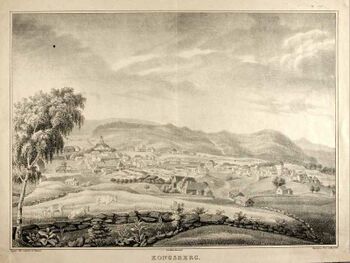
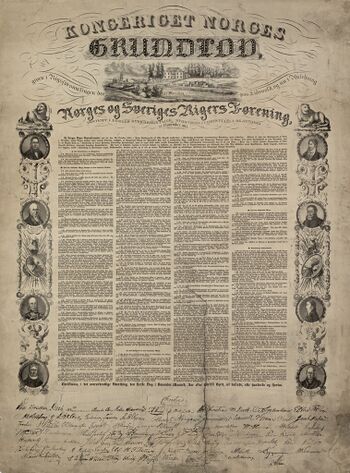
After short-lived lithographic practice in Copenhagen and Stockholm, the German portrait painter and draftsman Louis (Friedrich Ludwig) Fehr and his son Gottlieb Louis moved to Christiania (today Oslo) in October 1822 and started there the first lithographic printing house in the country. The company produced portraits of famous contemporaries, sheet music, illustrations for scientific publications of the University, administrative business forms (letterheads, invoices, exchange and lending documents), etc. Despite his growing business, Louis Fehr left Norway for Germany in Autumn 1824, and the company was taken over by his other son Carl Louis. [29] [30]
The bookseller Hans Thøger Winther, originally from Denmark (see below), opened his lithographic workshop in Christiania in 1823, and quickly became known for his extensive and varied production. He published portraits of famous Norwegians, landscapes and town prospects and lithographs of the Constitution. His large prospect of Christiania from 1835 provides an excellent view of the city and a number of important buildings. [31] [32]
Georg Prahl (Georg Carl Christian Wedel Prahl) opened a lithographic workshop in Bergen from Autumn 1828. He printed portraits, prospects, sheet music, maps, or a popular school atlas (1836). In connection with lithographs of national and peasant costumes he worked with artists such as Jacob Mathias Calmeyer, Joachim Frich, JFL Dreier and Hans Leganger Reusch. Between 1852–55 he served as chairman of Bergen Art Association [Bergens Kunstforening]. [33] [34]
Among more known painters, Erik Werenskiold, Edvard Munch (from 1894) and Henrik Sørensen worked with lithography. [35]
There are several lithographic workshops operating in Norway today. Grafisk Stentrykk in Oslo was established in 1991 and has two large 'snellpresser' automatic printing machines as well as possibilities for hand press-printing, intaglio printing (photogravure), and die stamping.
Photography[edit]
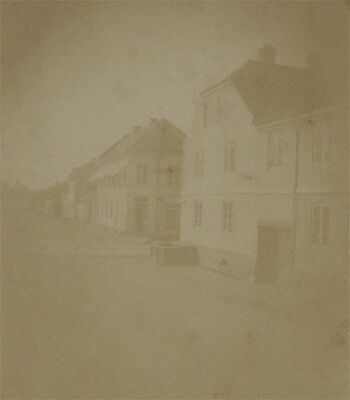
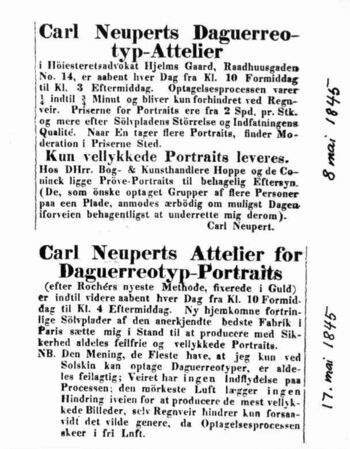
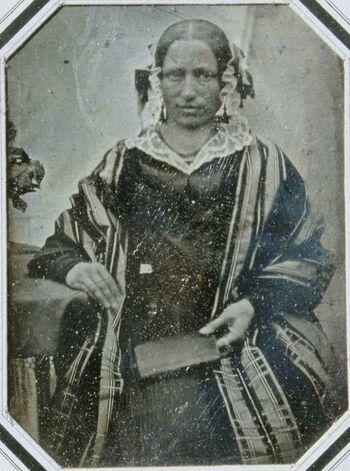
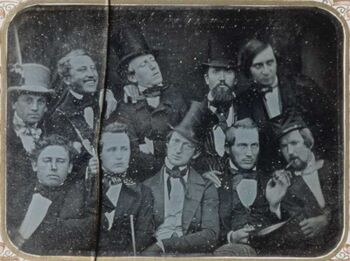
Photographers[edit]
- Hans Thøger Winther was born in Thisted in the north of Denmark, and moved to Christiania (today Oslo) in 1801 where he opened a book and music store [Boghandling [36] ] in his house in 1822, lithographic printing house [Steentrykkeri [37] ] in the basement in 1823, rental book library in 1825, book publishing house [Bogtrykkeri [38] ] in 1827, and published several magazines. He was making photographs between 1839 and 1851, as a hobby, never opening a studio. He had heard of Daguerre's discovery in 1839 and without knowing the details experimented with three techniques, direct positive on paper, negative/positive, and diapositive (it is not known that this technique was utilized in photography elsewhere). In 1842 he switched to using paper negatives. Wrote articles on photography as early as October 1839, and the first Norwegian handbook of photography, Anviisning til paa trende forskjellige Veie at frembringe og fastholde Lysbilleder paa Papir, published in 1845. [39] [40] [41]
- O.F. Knudsen was photographing in Christiania in 1840-61. [42]
- Carl Cetti Bendixen from Hamburg worked as daguerreotypist in Bergen in 1843. [43]
- Carl Stelzner, portrait painter and daguerreotypist with a studio in Hamburg, with many Norwegians among his students. He shortly worked in Christiania in August 1843. [44]
- Carl Neupert, student of Steltzner in Hamburg, ran his studio in Christiania from 15 May 1844 until 1846. He was also active in Kristiansand (1844), Trondheim (1844), Bergen (1844), St. Petersburg (1847), and in Helsinki and other locations in Finland (1848-49). [45] [46] [47]
- Frederik Ulrik Krogh showed a daguerreotype depicting Barrière de la Chapelle in Paris in the Bergen Art Association already in 1840. He worked in Bergen (1844-48) and Stavanger (1844-45). [48]
- Marcus Selmer from Denmark had his studio in Bergen from 1852 until his death in 1900. [49] [50] [51] [52] [53] [54]
- Knud Knudsen, learnt photography probably from Selmer in Bergen in the late 1850s, and ran his studio there from 1864 to c1915. [55] [56] [57] [58] [59] [60] [61] [62] [63]
- Anders Beer Wilse created massive photodocumentation of Norway in the first half of the 20th century. [64] [65] [66] [67] [68]
Events[edit]
- On 4 February 1839, Den Constitutionelle newspaper reported about Arago's speech in Paris from 7 January.
- October 1840, daguerreotype exhibition in Bergen.
- New Year of 1841, daguerreotype exhibition at Christiania Art Society [Christiania kunstforening], Christiania.
- Norsk fotohistorie – frå daguerreotypi til digitalisering exhibition, Preus museum, 2007. [69]
Resources[edit]
- Fotoregistrene [Photo Register], a database of photographers and photo collections/archives in Norway, started in 1992-93, ran by The National Library together with Preus Museum.
- DigitaltMuseum, contains historical photographs fotografier, artifacts, art, altogether more than a million items.
- OsloBilder hosts scans of ten daguerreotypes.
- Other resources.
Preservation[edit]
- Fotonettverket [Photography Network], national network for the preservation and dissemination of vernacular photography, includes more than twenty museums, archives and libraries.
Literature[edit]
- Ragna Sollied, Eldre bergenske fotografer, Bergen: Eget forlag, 1967. (Norwegian)
- Ragna Sollied, Eldre norske fotografer, Bergen, 1972. (Norwegian)
- Susanne Bonge, Eldre norske fotografer. Fotografer og amatørfotografer i Norge frem til 1920, Bergen: Universitetsbiblioteket i Bergen, 1980, 533 pp. (Norwegian) Contains information about 800 photographers.
- Roger Erlandsen, Vegard S. Halvorsen, Kåre Olsen, Inger Lise Rønning, Norske fotosamlinger 1989-90, Ad Notam Gyldendal, 1989, 232 pp. (Norwegian)
- Robert Meyer, Den glemte tradisjonen. Oppkomst og utvikling av en nasjonal landskapsfotografi i Norge frem til 1914: en temautstilling fra Robert Meyers fotohistoriske samlinger i anledning av 150-årsjubileet for fotografi, Oslo Kunstforening, 1989, 91 pp. Catalogue. (Norwegian)
- Oddlaug Reiakvam, Bilderøyndom – Røyndomsbilde: Fotografi som kulturelle tidsuttrykk Oslo: Samlaget, 1997. Dissertation. (Norwegian)
- Liv Hausken, Om det utidige. Medieanalytiske undersøkelser av fotografi, fortelling og stillbildefilm, Institutt for medievitenskap, Universitetet i Bergen, 1998. Dissertation. (Norwegian)
- Roger Erlandsen, Pas nu paa! Nu tar jeg fra Hullet! Om fotografiens første hundre år i Norge – 1839-1940, Inter-View & Norges fotografforbund, 2000, 323 pp. (Norwegian) [70]
- Gunnar Iversen, Yngue Sandhei Jacobsen (eds.), Estetiske teknologier 1700-2000, Scandinavian Academic Press, Oslo, 2003. (Norwegian) [71]
- Peter Larsen, Sigrid Lien, Norsk fotohistorie. Frå daguerreotypi til digitalisering, Oslo: Det Norske Samlaget, 2007, 344 pp. (Norwegian) [72], Review, Review.
- Jonas Ekeberg, Harald Østgaard Lund, 80 millioner bilder - Norsk kulturhistorisk fotografi 1855-2005, Forlaget, 2008, 343 pp. (Norwegian) [73], Review.
- CecilieTyri Holt, Edvard Munchs fotografier, Forlaget, 2013. (Norwegian)
Telegraph, Telephone, Radio[edit]
Optical telegraph[edit]

Until c1807, there was a flag signaling system in operation in Norway, between the coastal border with Sweden up to Stavanger.
In 1802, on the king's request, 'coastal telegrapher' Krigsraad Claus Grooss wrote a report in preparation to build the optical telegraph system in Norway. The report considered several options: improvement of the 'vardene' fire system from the Viking times, adoption of the Swedish optical telegraph (developed by Abraham Niclas Edelcrantz in 1794[74]), and its Danish counterpart (Lorenz Fisker, 1799[75]), however none of them were realised due to economical reasons. [76] [77] [78]
During the Napoleonic wars, Denmark-Norway and Sweden were neutral up until 1807, when Sweden joint the British, while after the British bombed Copenhagen, Denmark-Norway was forced by Napoleon in February 1808 to declare war on Sweden.
Shortly before that, Captain Ole Ohlsen was asked by the upper commander of Norway, prince Christian August, to reorganise the flag system; the result of which was that it took 75 minutes to deliver a message from Fredriksvern to Christiania (today Oslo), with each station taking 2 minutes to receive and send the signal. [79] [80]
- Ohlsen's telegraph
In 1808, still unhappy with the result, Ohlsen came up with his own version of Edelcrantz's optical telegraph. A telegraph line was eventually built along the coastal line between Hvaler and Namsos, followed by several mountain lines (the eastern from Hitteroy to Flekkefjord, the western from Stavenger and Bergenhus to Fedje, and the northern lines from Stadlandet to Kristiansund and from Kristiansten to Folda). The network counted 1300 km and 175 stations, built 6-8 km apart (other source claims 227 stations 4-5 km apart [81]). The system was used primarily by the Navy. Due to the rough weather conditions and high maintenance costs, the system collapsed after the war, in November 1814. [82] [83] [84] [85]
After 1804, Norway was part of the union with Sweden, where the optical telegraph system opened to civilian use in May 1837 and was used for business, weather forecasting, and search for missing persons. [86] [87]
Electromagnetic telegraph[edit]
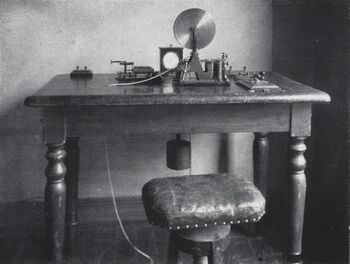
In 1848, King Oscar I. took a personal initiative in restoring the optical telegraph system on the basis of politically turbulent situation in Europe. Marine lieutenant C.T. Nielsen was sent to study optical telegraphy in Sweden, and reported that it was replaced by the electric one. [88]
The question was reopened in 1852 after influx of reports about civilian use of telegraph from abroad. After being first turned down by the parliament for financial reasons, the project was finally approved in April 1854. The newly founded Kongelige Elektriske Telegraf quietly opened Norway's first civilian telegraph line between Christiania and Drammen on 1 January 1855. In 1857, a nationwide network was made political priority. Bergen was connected the same year, Trondheim followed in 1858. [89]
In 1861, the 170 km long telegraph line (Lofotlinja) became functional on the Lofoten archipelago. The line was a mix of sea cables and land lines, and served nine fishing settlements which were being inhabited during the fishing season from January until March each year: Skrova, Brettesnes, Svolvær, Ørsvåg (moved to Kabelvåg in 1862), Henningsvær, Steine, Ballstad, Reine and Sørvågen. The line was connected with the rest of the country and Europe in 1867. [90] [91] [92]
The whole country was connected by 1870.
The Telegraph Company was among the first to allow women to work (1858); although in the 1880s only 10 percent of all operators were female. In 1920 they achieved the equal pay.
Wireless telegraph[edit]

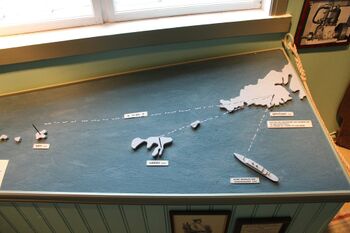
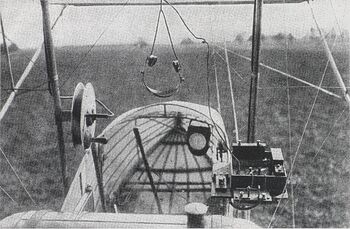
In 1901, the military began experimenting with wireless telegraphy, succeeding in 1902 in transmitting signal between the ships at Ferder and Horten, 40 km away apart. During the Union crisis in 1905 the military already had equipment to communicate between the ships and the ships and the land. First private ships with radio were Ellis and Preston in 1906; following years Marconi and Telefunken companies were selling radio equipment to commercial ships. [93]
Aside from the Navy, developments in wireless telegraphy in Norway were also motivated by the needs of fisheries, the country's major industry ever since the Middle Ages. The ability to send and receive messages about where the fish were and about changes in the weather was invaluable.
In 1902, Hermod Petersen, an engineer from the telecom authorities visited Sørvågen on the Lofoten archipelago. His investigations concluded that it would be possible to establish a wireless link from Værøy and Røst to Sørvågen, ie. to Lofoten and the rest of the country. The Norwegian parliament (Storting) granted 15,000 kroner to the project. The tests carried out in 1903 exceeded all expectations, and on 1 May 1906, a wireless link was opened between Sørvågen, situated on a tip of the Moskenesøya island, and Røst, on an island over 50 km away, using a Telefunken device. The line became the second radiotelegraph (spark telegraph) for civilian use in the world, after Italy. Petersen wrote an article about the project in the monthly sheet Tekniske Meddelelser fra Telegrafstyrelsen. In 1906, the staff at Sørvågen telegraph station made an unsuccessful effort to establish contact with Emperor Wilhelm II's ship, the "Hohenzollern II". The first successful connection with a ship at sea was eventually established on 1 July 1908. [94] [95] [96] [97] The station in Sørvågen became the Sørvågen museum in 1914 and later a branch of the Norsk Telemuseum [Norwegian Telecom Museum]). The four telegraph buildings that had been in use from 1861 are still in relatively good condition, as is the 70 metre high radio mast. [98] [99]
Two coastal radios were set up by Navy in Tjøme, Vestfold, and Flekkerøy near Kristiansand, in 1905. They were made mostly to listen to emergency channel for boat traffic and had 100 km range during the day and 400 km at night, having connection with Norwegian boats in Copenhagen, Dutch coast and far out in the North Sea. In 1910 they were taken over by the Telegraph Administration [Statstelegrafen] and began to be used for civilian correspondence as well. [100]
Shortly after, the coastal radio (wireless telegraph) stations were built at Finneset (on Spitsbergen, Svalbard, November 1911; from 1925 called Svalbard Radio; moved to Longyearbyen in 1930), Ingøy (north of Hammerfest, 1911), Bergen (September 1912[101]), and elsewhere. [102] [103]
Telephone[edit]
Under construction.
Radio[edit]
The state-owned Norwegian Telegraphy Administration [Telegrafvesenet] started working on a radio broadcasting in 1922. After consulting other countries, it recommended that the government own and operate the transmission infrastructure. Norway abolished the ban on listening to foreign radio without a permit in 1923. At the same time a permit became necessary to operate a transmitter. Financing of broadcasting was based on a combination of advertisements, license fees for owning a radio and fee on purchasing a radio. Several companies allied in 1922 for permits to operate radio channels. To avoid similar problems as had occurred in the United States, the administration tried to limited manufacturers of radios from also owning the channels. [104]
Kringkastingsselskapet [The Broadcasting Company] was granted the first permit in 1924. It had more than 2000 shareholders, with major parts owned by Marconi Company, Telefunken and Western Electric. It had a permit to operate a transmitter in Christiania with a reach of 150 kilometers. It was owned by Kringkastingsselskapet, but operated by the Telegraphy Administration. An additional five transmitters were built in Eastern Norway during the 1920s. These included Rjukan in 1925, Notodden and Porsgrunn in 1926 and Hamar and Fredrikstad in 1927. Norway was allocated three AM broadcasting frequencies in 1926. Other radio channels were established in Bergen in 1925, Tromsø in 1926 and Ålesund in 1927. [105]
The company began broadcasting on 29 April 1925 [106]. In 1928 it received permissions to operate in most of the country. In the beginning it was broadcasting a lot of music.
After several scandals, in 1933 Kringkastingsselskapet became part of the Norwegian Broadcasting Corporation [Norsk Rikskringkasting] (NRK) newly established as a government-owned, national broadcaster, with exclusive right to broadcast voice, music, pictures, etc, in the country. Its first channel, NRK 1, began operating the same year. [107]
Literature[edit]
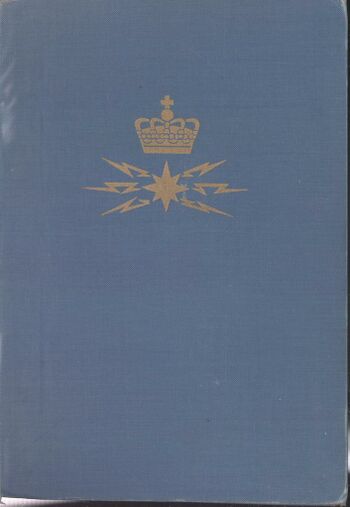
- Det Norske telegrafvesen: 1855-1929, Oslo: Telegrafstyret, 1929.
- Johan Medby, Gjennom splittelse og vanmakt til samling og styrke: det underordnede personale ved Telegrafverket i Oslo: interessestrid og faglig rørsle gjennom 50 år, Oslo, 1950.
- Thorolf Rafto, Telegrafverkets historie 1855–1955, Bergen: John Grieg, 1955, 637 pp. (Norwegian)
- Anton Blom, Norsk telegraf- og telefonforbund: gjennom 25 år 1930-1955, Oslo: Forbundet, 1955.
- Ole Kallelid, Leif Kjetil Skjæveland, Faget som varte i 100 år: historien til den trådløse telegrafien, Oslo: Norsk telemuseum, 1995, 64 pp.
- Ragnar Østvik, Nasjonen kommer frem over trådene : brytningstid i norsk telefonhistorie 1930-1948, Dragvoll: Senter for teknologi og samfunn, 1997. (Norwegian)
- Harald Rinde, Tall om tele: introduksjon til telegraf- og telefonstatistikken ca 1855-1993, Sandvika : Handelshøyskolen BI, 1997. (Norwegian)
- Richard Andersen, Dagfinn Bernstein, Kringkastingens tekniske historie, Oslo: Norsk rikskringkasting, 1999. (Norwegian)
- Harald Rinde, Norsk telekommunikasjonshistorie: Et telesystem tar form 1855-1920, Oslo: Gyldendal, 2005. (Norwegian)
- Per H. Lehne, "Enlightening 100 years of telecom history – From ‘Technical Information’ in 1904 to ‘Telektronikk’ in 2004", Telektronikk 100 (3), 2004, pp 3–9.
- Per H. Lehne, "The second wireless in the world", Telektronikk 100 (3), 2004, pp 209–213.
Sound recording[edit]
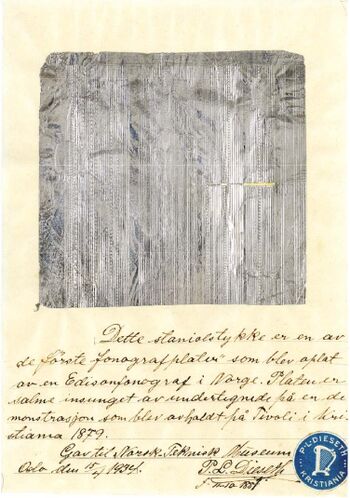

The oldest preserved sound recording made in Norway, 1879.
- A sound recording on tinfoil was made by the music retailer Peder Larsen Dieseth using Edison phonograph on 5 February 1879 at the Tivoli in Oslo. In 1934 Dieseth donated it to the National Museum of Science and Technology, and in 2009 it was digitised by the Research Institute for Industry at the University of Southampton; the recovery process is described here. [108] [109]
- The first gramophone disc in the country was recorded in December 1904 at the Grand Hotel in Oslo. The entertainer Adolf Østbye sang the song Bal i Hallingdal with Carl Mathisen on accordion. The disc is part of the Teknisk Museum's collection. [110] [111] [112]
- Literature
- Ivar Roger Hansen, Per Dahl (eds.), Verneplan for norske lydfestinger, Norsk lydinstitutt, 1997. [113]
- Vidar Vangberg, Norsk lydhistorie, 1879-1935: Historikk og veiledning i innsamling, registrering og anvendelse av historiske lydsamlinger, Oslo: Nasjonalbiblioteket, 1999, 87 pp. (Norwegian)
- Vidar Vangberg, Da de første norske grammofonstjernene sang seg inn i evigheten: Norsk grammofonhistorie 100 år Oslo: Nasjonalbiblioteket, 2005, 186 pp. (Norwegian). With a CD containing 25 recordings, mostly from the years 1904-05. [114]
- Hans Fredrik Dahl, Henrik Grue Bastiansen, Norsk mediehistorie, Vol. 2, 2008, 608 pp. (Norwegian) [115]
- Thomas Bårdsen, Fra evig is til evig tid. Bevaring av 100 år gamle lydopptak, for de neste 1000 år, Nesna, 2010. Master's Thesis. (Norwegian)
Film[edit]
Under construction.
Computing[edit]
Punched cards machines[edit]
The punched cards and the tabulating machines were initially developed for the U.S. census by the engineer Herman Hollerith (his company became the IBM in 1925). In 1894, the Central Bureau of Statistics in Norway [Statistisk sentralbyrå] (SSB) became one of his first customers abroad, and used a Hollerith tabulator for the censuses in 1900 and 1910.
Punched card machines as well as desk calculators were later used by the economists and the chemists at the University of Oslo, the meteorologists in Oslo and Bergen, the researchers at the Norwegian Defense Research Establishment (FFI), as well as in public offices, insurance companies, and industry. By 1940, there were 27 punched card installations in the country. [116]
Bull's punched cards machines[edit]
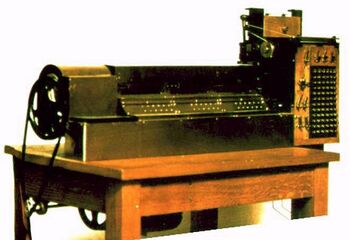
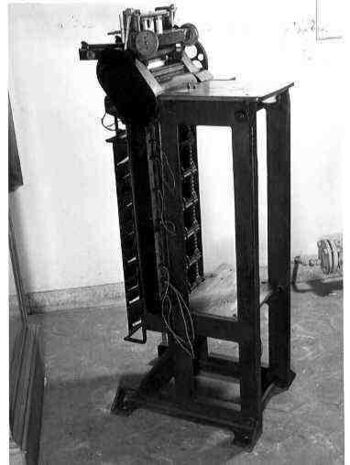
- Bull's first punched card machine at Storebrand
In 1916, the civil engineer Fredrik Rosing Bull was hired as a technical inspector of the insurance company Storebrand. After examining the Hollerith tabulating machines the company used, Bull concluded they were expensive and unstable. After two years of development at a workshop of the instrument-maker Kr. Ormestad, in January 1921 he presented to the Storebrand directors a machine which had several improvements against Hollerith's: the use of 45 columns punched cards allowed to read the information while making contact through the holes, and thus treat the information faster; and reduction of required manual work by standardization of punched-cards and pre-selection. Some parts of the machine were copied from the Hollerith's, to which he was allowed since IBM did not patented their machines in Norway. Even though Bull's machine was not sufficiently efficient, stable and reliable as expected, it was kept in operation until 1926. [117] [118]
- Oka company
In 1921, Bull teamed up with the hydraulic engineer Knut Andreas Knutsen. Oka company, owned by Knutsen's brother Reidar, took over the sales, repair and maintenance responsibility for the Scandinavian market. Following the advice of Henrik Hartzner, responsible for the statistical department of the Danish insurance company Hafnia, Bull divided the sorting and registering functions into two separate machines in 1923. [119]
Several insurance companies showed interest in the technology, especially in order to avoid Hollerith's monopoly on statistical machines. 2 machines were produced in 1921, 2 in 1922, 2 in 1923, 4 in 1924 and 6 in 1925, and were sold to (mostly insurance) companies in Norway, Denmark, Finland and Switzerland. [120]
Operation of the machines suffered from various problems, such as low durability of the material of the cards, the dust entering the holes of the contacts; frequent crashes because of sparks created by the contacts. Knutsen was constantly traveling, repairing and modifying equipment for the clients.
- Groupe Bull
Bull died of cancer in 1925; Oka company kept operating under Knutsen, improving the machines (the horizontal sorter in 1929, and a numeric wheel printing device in 1930). By the late 1920s, Bull machines emerged as one of the three main competitors of the IBM in the field of punched card machines in Europe, the other two being an American and a British company, both originally based upon the inventions by James Powers in the United States in the 1910s. [121] [122]
In 1927, the Belgian businessman Emile Genon who sold Elliot-Fisher and Underwood calculators bought the rights to Bull patents for the European continent (excluding Scandinavia), and in 1928 began producing Bull machines with the company H.W. Egli in Zürich. In 1931 he hired Knutsen and started with him a new company in Paris, called H.W. Egli-Bull, in 1933 renamed to Compagnie des Machines Bull, and later to Groupe Bull. The first tabulators produced in France were the T models (T30, T50, etc.). [123] [124] The company quickly rose to dominate the punched card machines market in France, where the major demand came from the governmental agencies. Ie., in 1934, Bull became the exclusive supplier to the French army. [125] [126] [127] [128]
On 12 March 2013, Reporters Without Borders named Amesys, a subsidiary of Groupe Bull, as one of the five "Corporate Enemies of the Internet" and "digital era mercenaries" for selling its EAGLE spyware to Gaddafi's Libya.
In 1993, The Technical Museum opened an exhibition of computer history which displays Bull's machines prominently, as well as Hollerith's system used by Statistics Norway.
Oslo Analyzer[edit]
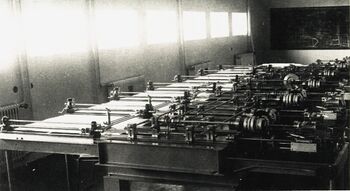
Professor Svein Rosseland at the Institute of Theoretical Astrophysics at the University of Oslo (UiO) searched for tools and new methods for solving differential equations. In 1934, he got the permission to build a differential analyzer based on drawings from Vannevar Bush, a professor at the Massachusetts Institute of Technology. This was a mechanical device to solve differential equations. After it was ready for use in 1937-38, it was the most powerful differential analyzer in the world for four years. It occupied about 100 square meters in the basement of the institute. The machine had twelve integrators (compared to six of the original MIT machine) and could calculate differential equations of the twelfth order, or two simultaneous equations of the sixth order. [129] [130] [131]
Early in the war, the Germans asked Rosseland for a meeting to see if they could use the analyzer to calculate ballistic formulas. When they later wanted to use it, Rosseland had gone to the US "on vacation". He became a professor at Princeton University for five years. Professor Brahde who had been present at the meeting could not help the Germans. They soon decided to dismantle important parts of the machine and bury them in the lawn in front of the institute. Without these parts, the machine would be of no use to the Germans. After the war, they reassembled and further developed the analyzer, also being supported by the Royal Norwegian Council for Scientific and Industrial Research (NTNF) in the 1950s. Ole Amble, who later became a key person in the software development for Norway's first electronic computer, made it possible to multiply on the machine. [132]
Jan W Garwick, who had been an assistant to Rosseland, moved to Norwegian Defense Research Establishment (FFI) in 1947 and as leader of the mathematical section, he became a key person in the development of scientific computing in Norway in the 1950s. [133]
NUSSE, Norway's first electronic computer[edit]
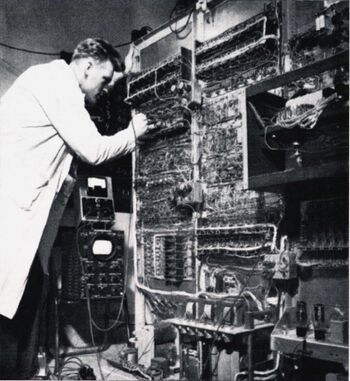
In 1948, the young scientist Henry Viervoll reported to the University of Oslo from his research trip in the United States that during the war the modern computers were developed. A Committee for Mathematical Machines was established at the Royal Norwegian Council for Scientific and Industrial Research (NTNF) in 1949 to lead the development of a Norwegian computer. Thomas Hysing was in charge of the construction. [134]
First, they planned for a Zuse machine, but after a visit by Professor D.R. Hartree from Cambridge, they discovered that, within budget, they could afford an electronic computer based on components from Andrew D. Booth who had constructed the APEX C. Construction of the input/output devices could take place in Norway at the Central Institute for Industrial Research (SI) that NTNF had established a year earlier. By this shift in strategy, they extended the time schedule by a year to 1954. They named the computer NUSSE. In 1953-54, Ole Amble and Tor Evjen, together with Werner Romberg from Trondheim, realised the mathematical coding and programming of NUSSE. [135] [136]
For the other users, in 1952 NTNF established the Norwegian Computing Center [Norsk Regnesentral] (NR) for pure and applied research as an organization with branches at the university sites and at FFI at Kjeller. The NR had at its disposal various punched card equipment, the differential analyzer at UiO, and later NUSSE and DIANA. In the beginning of 1954, a new tabulator, reproducer, collator, and sorter were installed at NR’s premises in Oslo. However by 1959-60 it developed into a commercial computing centre. [137]
DIANA analogue computer[edit]
Jens Glad Balchen, who returned in 1951 from a scholarship in the US, constructed DIANA (Differential Analyser), an analogue computer well suited for his work within the field of automation. He started in 1952; by 1955, this specialized machine was available, and was being developed further well into the 1960s. [138]
Military computers[edit]
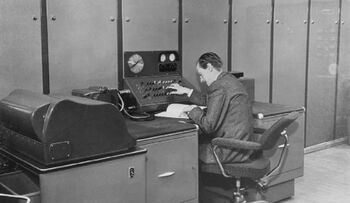
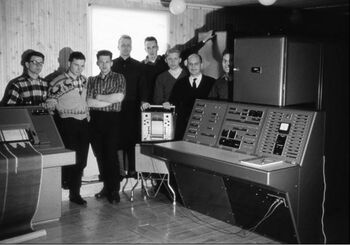
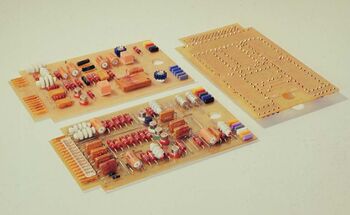
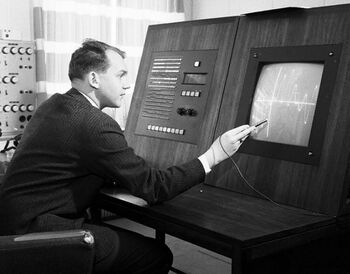
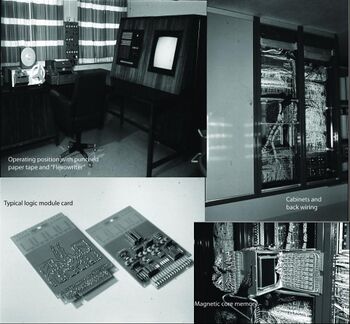
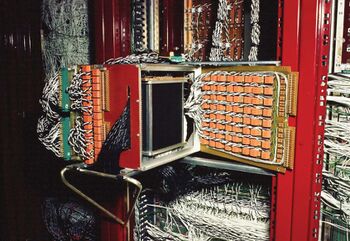
- Fredric
The Norwegian Defence Research Establishment [Forsvarets Forskningsinstitutt] (FFI) needed a computer to work on calculations of orbital mechanics for ballistic missiles and the dimensions for Kjeller Reactor, for which their punched card machine and desk calculators were insufficient. The head of mathematical department Jan W Garwick, previously involved in development work at the University of Manchester (in 1952), seized the opportunity and in 1957 acquired the first Mercury machine manufactured by Ferranti in Manchester. The machine was given the name Fredric (Ferranti Rapid Electronic Defence Research Institute Computer). The machine had 2000 vacuum tubes, 20 kW, occupied three floors, and came with no software. Several FFI engineers were involved in programming it: Ole-Johan Dahl, Harald Keilhau, Ernst Selmer, Svein Øvergaard and Per Kjeldaas; Dahl developed the language MAC based on Algol. Fredric was in operation for seven years, the users came from many scientific groups in the Oslo region. [139] [140]
- the Lydia digital signal processor
In the mid-1950s, the FFI was also looking for a way to intercept the communication of Russian submarines in the Norwegian waters, a transit zone between Soviet Union and the United States (within the Terne project[141]). Yngvar Lundh, who graduated from Trondheim's NTH with a thesis on digit-frequency system [Siffer-Frekvens-systemet] in 1956, was encouraged by the head of FFI's electronics research Karl Holberg to study at MIT. He spent a year at its Servomechanisms Lab (1958-59); worked with the TX-0 special-purpose programmable computer with transistor circuits (while learning to operate it he made a program that enabled people to play Tic-tac-toe with the computer using a light pen), saw Kenneth Olsen's presentation of PDP-1 computer (the first, transistorised, minicomputer), and worked with Larry Roberts among others. After his return, in 1960 Lundh formed a 'digital group' [Siffergruppen] with eight engineers, fresh university graduates, at FFI, and by March 1962 they completed an electronic computer for retrieving signals out of noise, in real-time. The Lydia machine ("lyd i a" means "sound in hers" in Norwegian) consisted of four large cabinets of transistorized digital circuits and was installed at Stave near Andøya where it was harvesting the submarine communication out of the intercepted noise. Digital signal processing was its only purpose, and it was not programmable. [142] [143] [144] [145]
- SAM
Afterwards, Lundh's group, joined by several new engineers, moved on to develop SAM (Simulation for Automatic Machinery). The machine was to analyse data from the test-fires of an surface-to-surface missile Penguin which was being developed at FFI from the early 1960s. The main challenge for the Siffergruppen was to build Norway's first general-purpose, programmable computer, which would be also superior to PDP-1. SAM was built between 1962 and mid-1964. It had 64x64x25 bit magnetic core memory (from Philips), seven 14-bit registers, eight special purpose registers, three data registers, an accumulator, a screen (Charactron), a light pen, a punched card reader and a Flexowriter. It used silicone transistors instead of germanium ones which were used at that time. It had a flexible input and output system and was connected to FFI's CDC 3600. The group developed two assemblers for programming the machine, Samba (SAM's Binary Assembler, developed by Martin Vånar) and Asem (from Lars Monrad-Krohn). SAM development was presented in a series of lectures at the Nordic conference NordSAM in Stockholm in August 1964. The machine was used at FFI until 1973. Since then, it has been on display at the Technical Museum in Oslo. [146] [147] [148] [149]
- Odin
In 1965-69, Landsverk and Krohn of Siffergruppen led the development of another computer, for the fire-control system Odin (another main component of the Odin system was a laser rangefinder, built by a newly formed Tycho Jæger's electro-optics group). The system required the production of a hundred computers; Krohn together with Per Bjørge and Rolf Skår started the company Norsk Data (its name went through several changes), but the commission was eventually won by Kongsberg Våpenfabrikk [Kongsberg Weapons Factory] (which employed Landsverk) due to its institutional links to FFI. KV went on to develop SM 4 (for the fire-control computation, to function also onboard the gunboats), while Norsk Data produced the minicomputers Nord 1, Nord 2 (a predictor that calculated data to be transferred to a rocket just before firing), and Nord 2B (for the general market). The two companies became the main rivals of one another for decades. [150]
Computers from abroad[edit]
In the late 1950s, several institutions installed their first general-purpose computers. Bergen's alliance of the University and ten companies, EMMA, rented an IBM 650 from April 1958; in summer it was used to calculate the taxes for about one million people. The Central Bureau of Statistics (SSB) installed a DEUCE from English Electric on behalf of NR in February 1959, and an IBM 1401 in 1961 (used for the census of 1960). In December 1960, a Wegematic arrived from Sweden in the University of Oslo, and was used there mostly by the chemists; it was replaced by an IBM 1620 in 1962. From June 1961, the Norwegian Meteorological Institute (DNMI) operated a Swedish FACIT. In November 1962, the Norwegian Institute of Technology (NTH) in Trondheim bought its first digital computer, GIER (it had an Algol 60 compiler), from Denmark; it was used for education by Knut Skog and the British Boeing engineer Norman Sanders, with more than 500 students and employees taking programming courses in the first year. [151]
Simula 67, the first object-oriented language[edit]
In August 1963, UNIVAC 1107 arrived at NR from the States. It was the first commercial computer to bridge the gap between computers for scientific or for administrative tasks, and its installation at NR was the largest civil computer installation in Europe at the time. The machine was bought through a loan which was paid back through revenue from its use in research and industry (shipbuilding, seismic activities, oilrig construction, engineering control, building industry). [152]
NR developed a linear programming package and a simulation language with a corresponding compiler for the machine, continuing the research which started at the FFI [153]. The language, Simula I (developed in 1961-65), was the precursor of the Simula 67 language that introduced the concept of object-oriented programming and gave its two authors Ole-Johan Dahl and Kristen Nygaard (Research Director at NR in 1960-84) the IEEE von Neumann Medal and the ACM Turing Prize 35 years later. Simula introduced the concepts upon which all later object-oriented programming languages have been built: objects, classes, inheritance, virtual quantities and multi-threaded (quasi-parallel) program execution. [154]
Two of the three Norwegian universities at the time acquired Univac computers, as did several of NR’s large customers (Norsk Hydro, Veritas, the Norwegian Teleadministration). Oslo University went for a CDC 3300, although the University was for several years a very strong user of NR facilities. Trondheim's NTH used model 1004 from 1964 that communicated with NR, and model 1107 from May 1965. [155]
Computing research entered into a wider public awareness through the widely medialised conflict between NR and NTNF in January 1970. [156]
Key figures[edit]
Fredrik Rosing Bull, Svein Rosseland, Jan W Garwick, Ole-Johan Dahl, Kristen Nygaard, Yngvar Lundh, Lars Monrad-Krohn.
Research institutes[edit]
- Royal Norwegian Council for Scientific and Industrial Research [Norges Teknisk-Naturvitenskapelige Forskningsråd] (NTNF) existed from 1946 until 1992, when it merged together with another four research councils to create The Research Council of Norway. [157] [158]
- Norwegian Defence Research Establishment [Forsvarets Forskningsinstitutt] (FFI), established in 1946, based since 1947 in Kjeller near Lillestrøm (20 km east of Oslo). The institute had its roots in British WWII research, in which many Norwegian scientists/technologists participated (Norway was occupied by the Germans 1940–45). [159]
- Central Institute for Industrial Research (SI), established by NTNF in 1950 with an intention to work closely with the Faculty of Mathematics and Natural Science at the University of Oslo. In 1993 it merged with SINTEF.
- Foundation for Scientific and Industrial Research [Stiftelsen for industriell og teknisk forskning] (SINTEF), established by NTH, Trondheim, in 1950. [160]
- Norwegian Computing Center [Norsk Regnesentral] (NR), established by NTNF in 1952. [161]
- Punchcard club Team [Hullkortklubben Team], *1953, tied to IBM. From 1961 the Norwegian Computer Application Society [Norsk Databehandlingsforening] (DBF). In 1976 it merged with NSEI into DND. [162]
- Norwegian Society for Electronic Information Application [Norsk Selskap for Elektronisk Informasjonsbehandling] (NSEI), *1960. In 1976 it merged with DBF into DND. [163]
- Telegrafverkets forskningsinstitutt (TF), later Televerkets forskingsinstitutt, a research laboratory of the Telecom, established in 1967 and located just next to FFI in Kjeller. In 2001 it was renamed to Telenor R&I. [164]
- The Norwegian Computer Society [Den Norske Dataforening] (DND), established in 1976 in the merge of DBF and NSEI. [165]
Literature[edit]
- Books, Reports
- Per Øyvind Heradstveit, Eventyret Norsk Data: En bit av framtiden, Oslo: J.M.Stenersens Forlag, 1985. (Norwegian)
- O. Wicken, Norsk datahistorie, Ingeniørforlaget/Teknisk Ukeblad, 1989. (Norwegian)
- Den Norske Dataforening, Data gjennom 40 år, Oslo: Ad Notam Gyldendal, 1993. (Norwegian)
- Jan Rune Holmevik, Educating the Machine: A Study in the History of Computing and the Construction of the SIMULA Programming Languages Trondheim: STS Report 22/94, 1994. [166]
- Data historien ved Universitiet i Oslo: Fra begynnelsen til ut i syttiårene, Oslo: University of Oslo, 1996. (Norwegian)
- Olav Njølstad, Olav Wicken, Kunnskap som våpen: Forsvarets forskningsinstitutt 1946–1975, Oslo: Tano Aschehoug, 1997. (Norwegian)
- Arild Haraldsen, Den forunderlige reisen gjennom datahistorien, Oslo: Tano Aschehoug, 1999. (Norwegian)
- Jon Gulowsen, Bro mellom vitenskap og teknologi: SINTEF 1950-2000, Trondheim: Tapir, 2000.
- Norsk Regnesentrals historie 1952–2002, Oslo: Norsk Regnesentral, 2002, 392 pp. (Norwegian) [167]
- Arild Haraldsen, 50 år – og bare begynnelsen: Norsk IT-, tele- og Internett-historie gjennom 50 år, Oslo: Cappelen Damm, 2003, 424 pp. (Norwegian) [168]
- Fra Forsvarets forskningsinstitutts historie: Datateknologi, FFI, 2003. (Norwegian)
- Book chapters, Papers, Articles
- E.Barca, "Den annen datapioner i Norge, ingeniør Fredrik Rosing Bull", 1973. (Norwegian)
- Pierre E. Mounier-Kuhn, "Bull: A World-Wide Company Born in Europe", IEEE Annals, Vol. 11, No. 4 (Winter 1989), pp 279-297. [169]
- Pierre E. Mounier-Kuhn, "BULL l'histoire très internationale d'un géant français", Science et Vie Micro 74 (July-August 1990). (French)
- "History of Bull", an extract translated to English.
- Lars Heide, "From Invention to Production: The Development of Punched-card Machines by F.R.Bull and K.A.Knutsen 1918-1930", IEEE Annals of the History of Computing, Vol. 13, No. 3, 1991, pp 261-272.
- Per A. Holst, "Svein Rosseland and the Oslo Analyzer", IEEE Annals of the History of Computing 18(4), 1996, pp 16-26. [170]
- Lars Heide, "National Capital in the Emergence of a Challenger to IBM in France", 2002.
- Ulf Uttersrud, "F. R. Bull: Ingeniør, oppfinner og IT-pionér, 1882-1925", Teknologihistorie website, undated. (Norwegian)
- Drude Berntsen, "The pioneer era in Norwegian scientific computing (1948-1962)", in History of Nordic Computing, Springer, 2005, pp 23-32.
- Rolf Skår, "History of Nordic Computer Industry as Seen From Norway", in History of Nordic Computing, Springer, 2005, pp 184-185.
- Knut Elgsaas, Håvard Hegna, "The Norwegian computing center and the Univac 1107 (1963-1970)", in History of Nordic Computing, Springer, 2005, pp 449-462.
- Lars Heide, "Facilitating a Challenger: Industry Standards in the Development of the Bull-Knutsen Punched Card System 1919 – 1931", paper for the EBHA conference in Geneva, 2007.
- Lars Nerdrum, Magnus Gulbrandsen, "The technical-industrial research institutes in the Norwegian innovation system", TIK Working paper on Innovation Studies No. 20070614, 2007.
- Ola Nordal, "Tool or Science? The History of Computing at the Norwegian University of Science and Technology", in History of Nordic Computing 2, Springer, 2009, pp 121-129.
- Norodd Hagenson, "Operations Analysis Computing at FFI, 1970–1995", History of Nordic Computing 3, Springer, 2011, pp 35-42.
- Jan Engh, "IBM’s Norwegian Grammar Project, 1988–1991", History of Nordic Computing 3, Springer, 2011, pp 137-149.
- Yngvar Lundh, "Norwegian Computer Technology: Founding a New Industry", History of Nordic Computing 3, Springer, 2011, pp 240-248.
- Tor Olav Steine, "The Founding, Fantastic Growth, and Fast Decline of Norsk Data AS", History of Nordic Computing 3, Springer, 2011, pp 249-257.
- Peter H. Hughes, "Computer Systems Performance Engineering in Trondheim: Origins and Development, 1970–1995", History of Nordic Computing 3, Springer, 2011, pp 315-322.
- Birger Møller-Pedersen, "Scandinavian Contributions to Object-Oriented Modeling Languages", History of Nordic Computing 3, Springer, 2011, pp 339-349.
- Yngve Sundblad, "Simula: Mother Tongue for a Generation of Nordic Programmers", History of Nordic Computing 3, Springer, 2011, pp 416-424.
Television[edit]
Under construction.
Internet[edit]
Early data transmissions[edit]
First demonstration of data transmission in Norway took place in April 1963 from the Norwegian Computing Center (NR) to Sweden, with senior managers in the Swedish and Norwegian telecoms present. In autumn 1964, data were regularly transmitted using the telephone line between the NR's "big" UNIVAC 1107 computer in Oslo and the Norwegian Institute of Technology (NTNU) in Trondheim. In the latter happening then too technical research. [171]
Norway in Arpanet[edit]
In 1968, the United States and the Soviet Union signed the Nuclear Test Ban Treaty committing themselves to halt their underground nuclear tests. A seismic observatory was opened in Montana, US, followed by the NORSAR (Norwegian Seismic Array) in Hamar, Norway, in 1970. Data exchange between them was assisted by a 2.4 kb/s leased line. A network of observatories later expanded to Alaska, Iran, and South Korea. [172] [173]
In September 1972, Larry Roberts and Bob Kahn of ARPANET visited institutions in Norway and presented their project, also talking about possibility to open up packet-switching satellite channels, which would benefit Norway's worldwide shipping industry (Roberts, director of ARPA's Information Processing Techniques Office, previously visited Norway in May 1970 and discussed cooperation with Televerket, to no success). Next month, Yngvar Lundh of the Norwegian Defence Research Establishment [Forsvarets Forskningsinstitutt] (FFI) visited a conference on computer networking in Washington and participated in the meetings of the Packet Switching Project Working Group (PSPWG). There he made new contacts at ARPA, SRI and UCL and with other members of that group. Upon his return, Lundh began a project on radio computer technology (Rada) at FFI, from 1975 being joined by Pål Spilling. [174] [175] [176]
ARPA sponsored a Terminal Interface Message Processor (TIP) installed in summer 1973 in Kjeller to connect it to its base in the States. Improved modems transmitting 9.6 kb/s were connected in the existing cross-Atlantic line. Multiplexers rendered 7.2 kb/s for the TIP while the seismic traffic kept its 2.4 kb/s. Shortly thereafter, a second European node was assembled at UCL (University College of London) connected by a line from Kjeller. The next node outside the US was installed in Germany in 1980. [177] [178]
Between August 1974 and c1982, ARPA's PSPWG group was organising a two-day meeting of 20-30 participants every three months. Venues rotated between the ten groups of researchers from ARPA, SRI (Stanford Research International), BBN (Bolt Beranek and Newman), Linkabit, ISI (Information Sciences Institute), UCLA, Comsat, MIT, UCL, and FFI. Two of them took place in Norway, in the premises of FFI in Kjeller, on 29-30 June 1976 and 8-10 June 1977. These meetings were essential during the most active period of internet's technological development. Lundh summarizes: "Robert Kahn, who replaced Roberts in 1974, was the quiet and efficient leader of those meetings. Jon Postel of ISI was the gifted author of many clear and precise documents – RFCs. Vint Cerf was a most active participant in the discussions. Typically, he pursued all questions persistently until the group considered every conceivable situation. Individuals communicated intermediate discussions and practical arrangements by email between meetings. In summary, the most important goals were as follows. A) Any type of information transport medium should be made useful for optimal packet transport. B) Any type of traffic should be managed in accordance with its specific need. C) The network should be robust and working without any central control." [179]
In May 1976, Lundh arranged a seminar in Kjeller and invited some twenty persons from academia and industry. He obtained an international grant allowing me to invite Douglas Engelbart to present his ideas on "Computer Augmentation of the Human Intellect". The experienced and charming inventor lectured his ideas to us for three whole days. He brought and demonstrated his invention, the workstation with CRT and mouse. That was years before people even had seen such screens. The idea didn't resonate. [180]
After years of persuasion, Televerkets forskningsinstitutt (TF) of Norwegian Telecom Administration (NTA) finally agreed in late 1976 to borrow FFI a free satellite channel and a line via the Nordic ground station at Tanum, Bohuslän, in Sweden to experiment with packet satellite transmission. Later also UiO and NTH were connected. [181]
By August 1978, Lundh's "Arpanet group" grew to five people (incl. Øyvind Hvinden, Finn-Arve Aagesen, and Åge Stensby) and was formalized as the 'Paradis' project with the research mission expanded to packet switched radio channels and distributed information systems. [182] [183]
Pål Spilling spent a year at Stanford Research International (SRI) from 1979 to 1980. He was helpful in making the network become available beyond FFI in Norway in the 1980s. He began teaching classes in computers and communications. He joined NTA’s research department; had taught in the area of computers and communications at UNIK, Kjeller; and founded Skrivervik Data company with Helge Skrivervik to distribute SUN machines in Norway. Aagesen and Hvinden have also worked in the area of computers and communications since then. [184]
UNINETT[edit]
Significant networking efforts took place at universities in Oslo, Bergen, Trondheim, and Tromsø in the 1970s and 1980s, independently of the efforts at FFI and the internet technical development. The Norwegian research and development network UNINETT was established in 1976 as the initiative of the University of Oslo, Televerkets forskningsinstitutt (TF) and the Norwegian Institute of Technology (NTH). From 1978 it functioned as a packet switched service, with all major university machines connected to it using the X.25 protocol by next year. Initially, it was funded by the participants, in 1981 the NTNF took over the costs. By 1983, all Norwegian universities were linked via UNINETT and the first international connections were established. A similar public X.25 network, SUNET, operated in Sweden from 1980. [185] [186]
Datex[edit]
Datex was an early public data network service based on digital circuit switching. Datex network came into regular operation in Norway in 1981 and came to cover the Nordic countries, Germany, Austria, USA (Western Union) and Canada. At its peak, the network counted 12,000 subscriptions among companies and government agencies in Norway. [187]
Datapak[edit]
Datapak was a data communications service that used packet switching networks, with either a fixed connection (X.25) or dial-up (X.28). It came into regular operation in Norway on 1 January 1984 by Telecom. [188]
NORDUnet[edit]
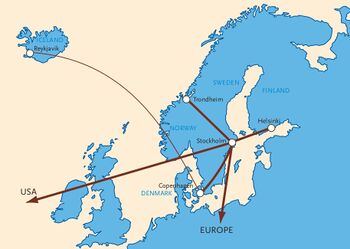
NORDUNET began as an informal cooperation between Nordic "networkers' in 1980. With support from the Nordic Council of Ministers, a NORDUNET project for a common Nordic academic network began in 1985, led by Mats Brunell (Sweden) and Einar Løvdal (Norway). Originally based on existing interim services of EARN (based on BITNET and running on international leased lines sponsored by IBM), DECnet and ISO OSI support, a lack of services led to complete reorientation in 1987. With bridges running Ethernet over slow lines, a Nordic-wide Ethernet connecting major nodes in the countries linked national Ethernets to a common node at KTH, Stockholm. The major services of the time, X.25, EARN and RSCS, DECnet, and TCP/IP, were connected in through switches, bridges and routers called "the NORDUNET plug". [189]
The NORDUnet, the first international multi-protocol network, began services in 1988 and officially opened in 1989. Major links to the US NSFnet and European networks connected to the KTH node. The project had a strong impact on Nordic networking competence that influenced the European move to TCP/IP services in opposition to the prevailing adherence (politically supported) to ISO OSI. Over time, TCP/IP won the "protocol war". NORDUnet is today owned by the national ministries, run through cooperation by the national networks. [190]
The NORDUNet's website, nordu.net, is the oldest active domain name; it was registered on 1 January 1985. [191]
Commercial internet services[edit]
In 1985, Norwegian Telecom Administration's technical director Ole Petter Håkonsen hired Yngvar Lundh to develop public email. During the rest of the 1980s, that effort led to a limited success when the Telepost company began to provide electronic mail service. Telepost grew quite fast and issued email address books. [192]
- Web
The first company that allowed people from outside the higher education system to access the internet was Oslonett, founded in December 1991. The first web server of the Oslonett was up by the summer 1993. [193]
In the mid-1990s the internet began to be mentioned in the media and generally known, notably in connection to Oslonett's Kvasir web search. [194]
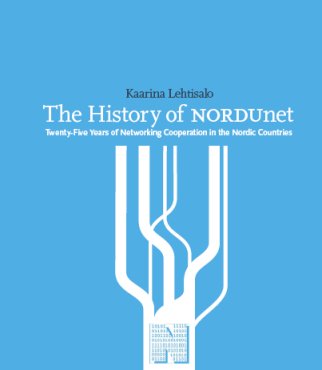
Literature[edit]
- Lars Backström, "NORDUNET, University Network in the Nordic Countries", in Information Network and Data Communication, IV, Proceedings of the IFIP TC6 International Conference on Information Network and Data Communication, Espoo, Finland, 1992, pp 247-261.
- Fra Forsvarets forskningsinstitutts historie: Datateknologi, FFI, 2003.
- Kaarina Lehtisalo, The History of NORDUnet: Twenty-Five Years of Networking Cooperation in the Nordic Countries, 2005.
- Rolf Nordhagen, "NORDUNET: The roots of Nordic networking", in History of Nordic Computing, Springer, 2005, pp 391-404.
- Yngvar Lundh, "Development of Internet Technology and Norwegian Participation", History of Nordic Computing 3, Springer, 2011, pp 287-296.
Satellite[edit]
Under construction.



